

1972
LNP-2L changed into THE ORIGINAL ML module specification from the product made by Burwen carried in LNP-2.
It is a three unit composition of phone amplifier, input amplifier, and output amplifier, one module per channel for each stage.
The amplification part consists of a total of eight modules. The input/output terminals are "LEMO connectors" of a CAMAC system used for medical equipment and a physics measuring instruments.
Moreover, the canon type connector is used in the Tape input/output and the Main out output, respectively.
The LNP-2 established the concept of high-end audio. A Low-Noise Preamplifier,
It proved that solid-state circuits could not only meet, but also dramatically exceed the performance of tube electronics.
Its peak-reading VU meters could capture the first quarter of a 20kHz waveform and today is regarded as the cornerstone of the ultrahigh-end audio component industry.
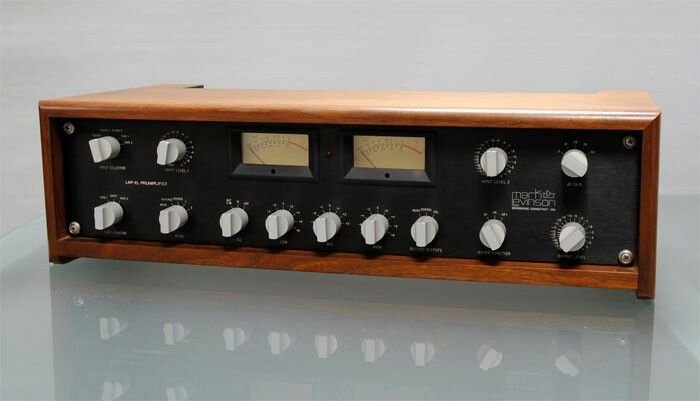
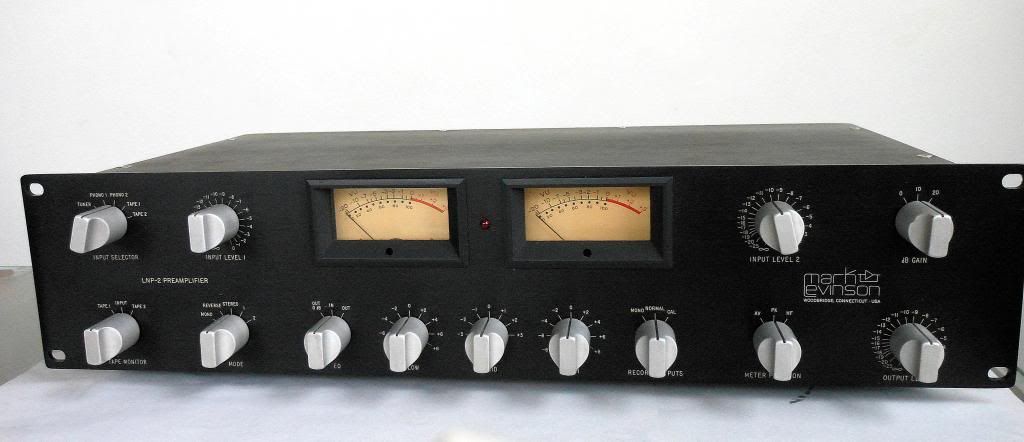
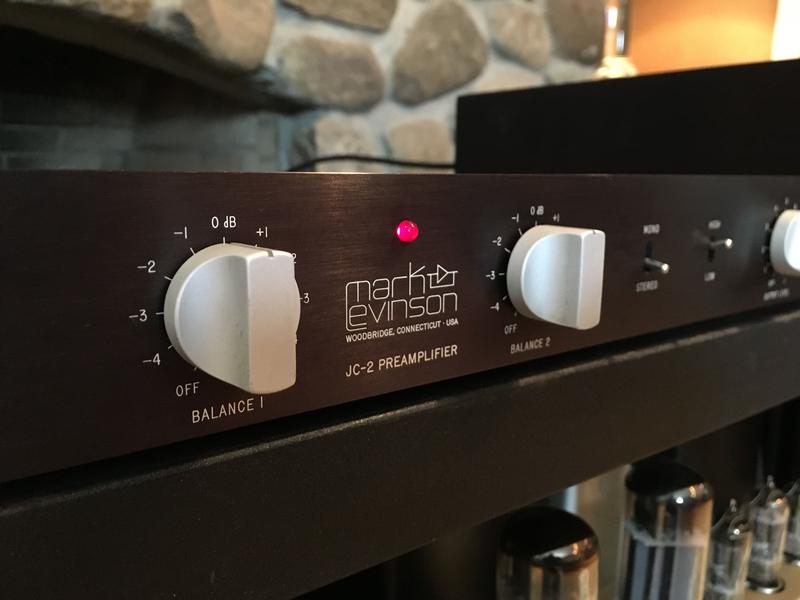
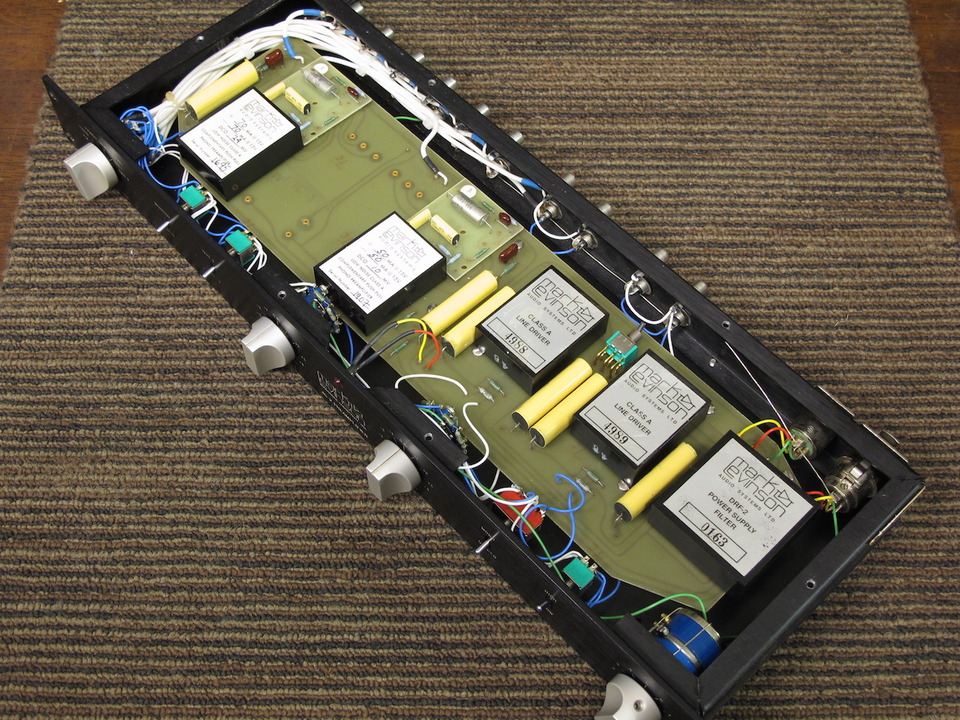
JC-2
1974 ?
This is a legendary preamp designed by John Curl and built in the USA by Mark Levinson.
Though slimmer in design than its predecessor, this Flat Preamplifier achieved even higher sonic quality.
Its iconic, low-profile design became a fundamental element of later Mark Levinson preamplifiers.
Hand matched active components
Special thermal epoxy potting compound for modules
1% low noise metal film resistors
1% tolerance polycarbonate capacitors in the audio path
Gold plated contacts and switches
Teflon insulated wiring throughout Conductive plastic input and output pots
Aluminum anodized chassis throughout
Employing simple circuitry this John Curl design was a scaled down version of the LNP-2 dispensing with the facilities that would not be required by domestic users but retaining the high build quality.
Surprisingly for an item intended for domestic use, it was designed for 19” rack fitting, although a wooden sleeve or case was made available.
It received very favourable reviews at the time, despite the high price.
Again for the domestic market RCA connectors were employed as in the JC-1, though later versions of the JC-2 came equipped with CAMAC connectors.
JC1, JC1-AC & JC-1DC
1977
A Classic! Designed by John Curl.
The DC version is battery powered.
The JC-1AC obviously runs off AC.
Its only for MC cartridges
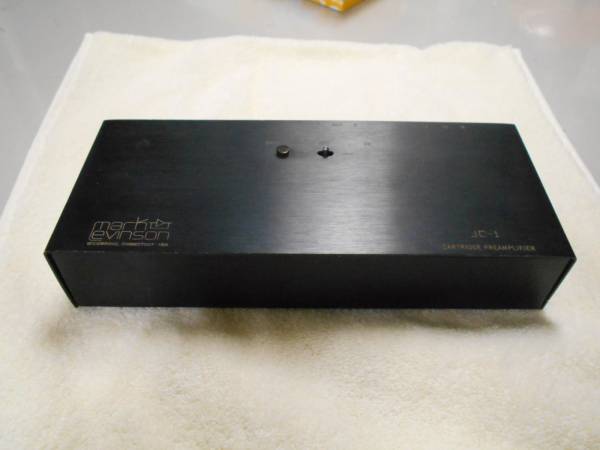
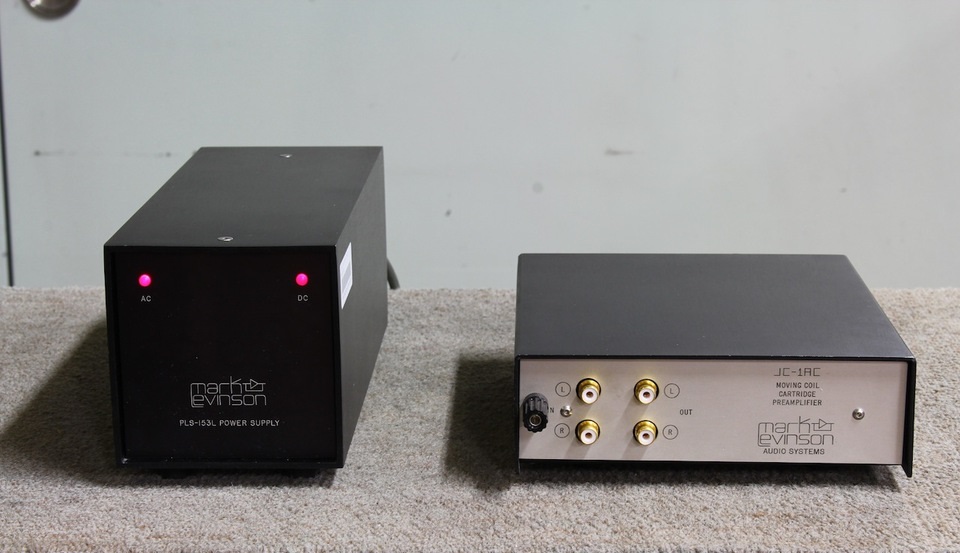
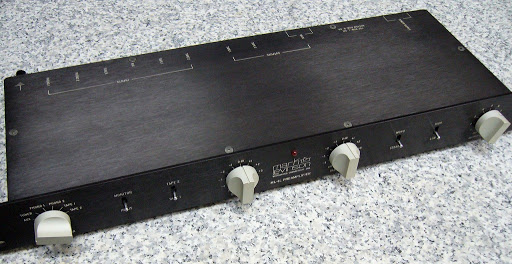
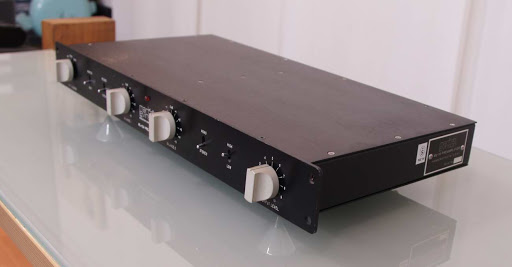
ML-1
1977-1980
The ML1 preamplifier with its unique design and performances was one of the best preamplifier of its time and still is despite the difficulty of repair.
Designed probably by John Curl (and also probably Tom Colangelo). Some sources state that it should have been name JC-x
This is the first design to be given the new ‘ML-‘ designation. The ML-1 is virtually identical to its predecessor the JC-2.
John Curl parted company from Levinson, going on to work with Harmon-Kardon, Gale, SOTA, Saul Marantz (in The Lineage Group) and Parasound where his basic design for the JC-2 continued in the Halo JC-2 preamp, also producing his own Vendetta Research phono amplifiers.
Mark Levinson redesigned the external power supply and renamed the preamplifier the ML-1.
The front panel, controls and facilities are the same as that of the JC-2.
Custom plug in modules were available, allowing a variety of pick up cartridges to be accommodated.
ML-2
1977-1986
The ML-2 is a massive class A mono amplifier. It's output power is often advertised to be 25 watts but it's actually more than that, maybe up to 100W.
For this reason, Ml-2s work best with higher efficiency loudspeakers, in multi-amp systems, or with lower efficiency speakers where loud listening levels are not required.
A critical link connecting audio sources to the loudspeaker, Mark Levinson unveiled their version of the power amplifier in 1977 with the ML-2:
a Monaural component that truly matched the glory of the music. Due to its unparalleled sound quality and outstanding speaker driving capability, the ML-2 was soon adopted as a reference amplifier by a number of leading audio magazines and loudspeaker manufacturers.
The ML-2 Power Amplifier This power amplifier is the last design for Levinson that John Curl made. The prototype (pre-production) John Curl design was called the JC-3.
The ML-2 was based on the JC-3, and was completed by Levinson’s chief engineer, Tom Colangelo.
The design went into production in 1977. MLAS recognised that there was more to sound quality than measured figures and only supplied specifications that related directly to the operation of the amplifier.
A 25-watt single channel (monoblock) amplifier operating in class A, the ML-2 would develop 50 watts into 4Ω and 100 watts into 2Ω.
The ML-2 used a high quiescent current, causing it to dissipate some 400 watts whilst idling and consequently ran very hot.
Because of the high running temperatures there were reliability problems. Production stopped in 1986.
The ML-2 was able to source a current of 8A into 10Ω, owing to the fully regulated power supply possessing a claimed equivalent of 1Farad of smoothing/storage capacitance.
It had both normal and inverting inputs and was bridgeable to give four times the rated output power.
There was also an option for the ML-2 to be fitted with XLR connectors for balanced inputs. It was designed to partner the ML-1 preamplifier.
Despite the seemingly low 25W into 8 ohm output power, the ability to double this progressively as impedance was halved, coupled with high current delivery made the ML-2 the favoured amplifier to drive the original full range Apogee loudspeakers with their 0.3 Ohm load.
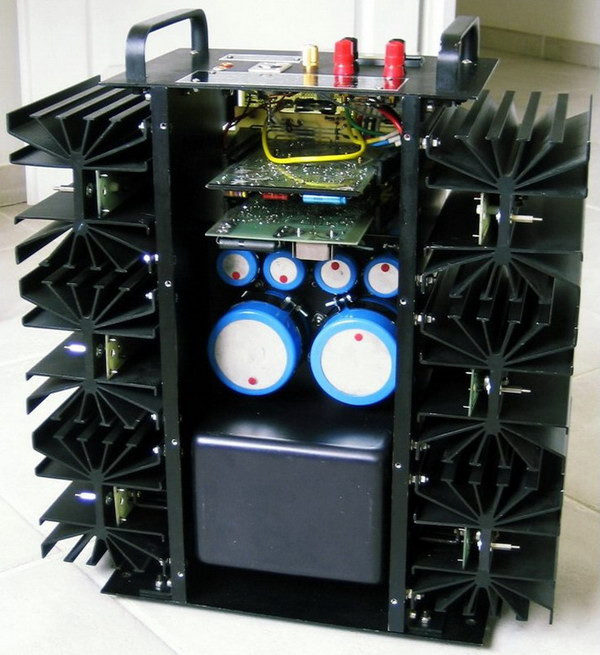
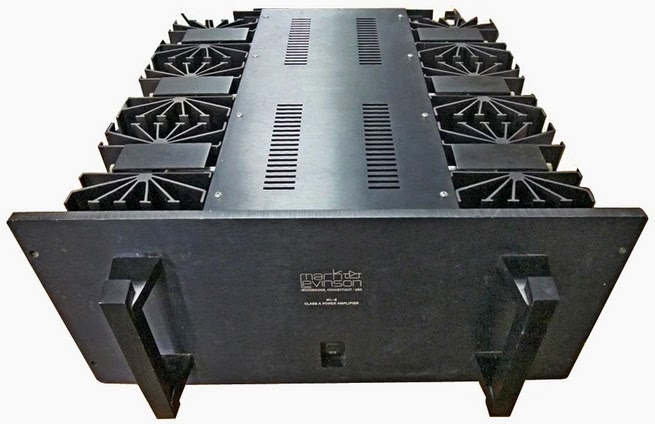
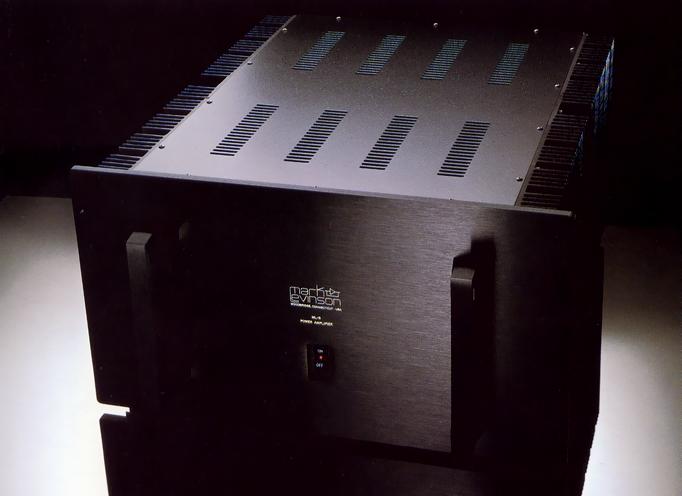
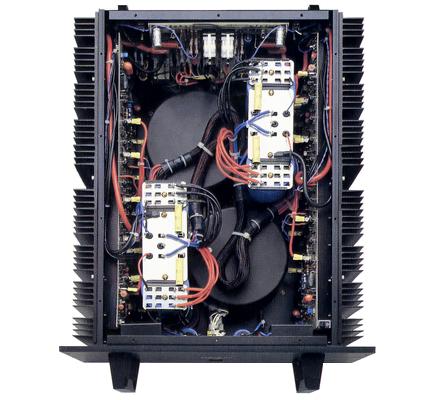
ML-3
1979-1987
The Mark Levinson ML-3 was a 200 watt per channel dual monaural Class AB2 power amplifier that used toroidal transformers.
Produced between 1979 and 1987, the ML-3 consisted of two electrically separate amplifiers in one chassis, hence the name "Dual Monaural". It also featured discrete circuit construction; no integrated circuits were incorporated to keep the signal pure.
The design was by Thomas P. Colangelo.
200 W/channel at 8 ohms,
400 W/ch at 4 ohms,
800 W/ch at 2 ohms
Maximum output: 45 volts 30 amperes
Two 1.2 kVA Avel Lindbergh toroidal transformers,
4 Sprague 36,000 µF, 100 V capacitors and 40 output devices (20 per channel)
Range: 20 Hz to 20 kHz with less than 0.2% total harmonic distortion
Gold-plated CAMAC input connectors Adjustable AC voltage:
No, factory set Adjustable output damping toggle switches (one per channel) (in later models only)
Weight: 116 lb (56 kg)
ML-6
1979-1980/5
The ML-6 preamplifier is a mono unit : you need two of them.
They have an external power supply (ML-6 Power supply or PLS-154), and obviously lack of a balance button 🙂
The ML-6 will be upgraded twice by model ML-6A and later the ML-6B.
They are of course modular. You can't imagine a simpler preamp with only two buttons on the facade, the input selector (3 positions, Phone, Off, Line, labeled SOURCE) and the volume

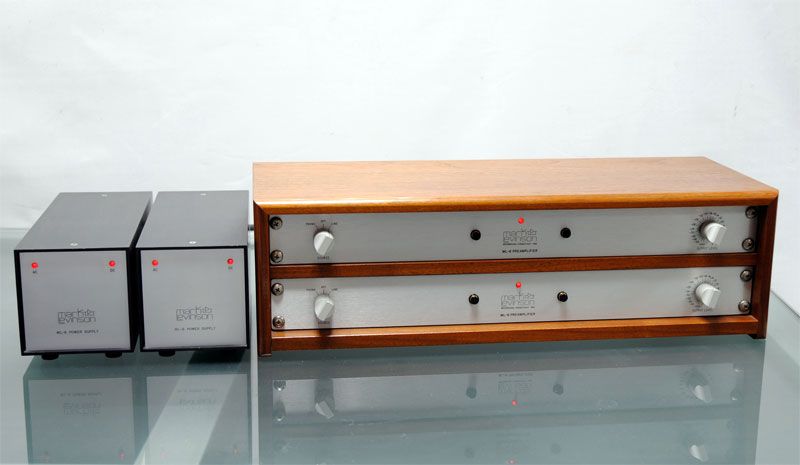
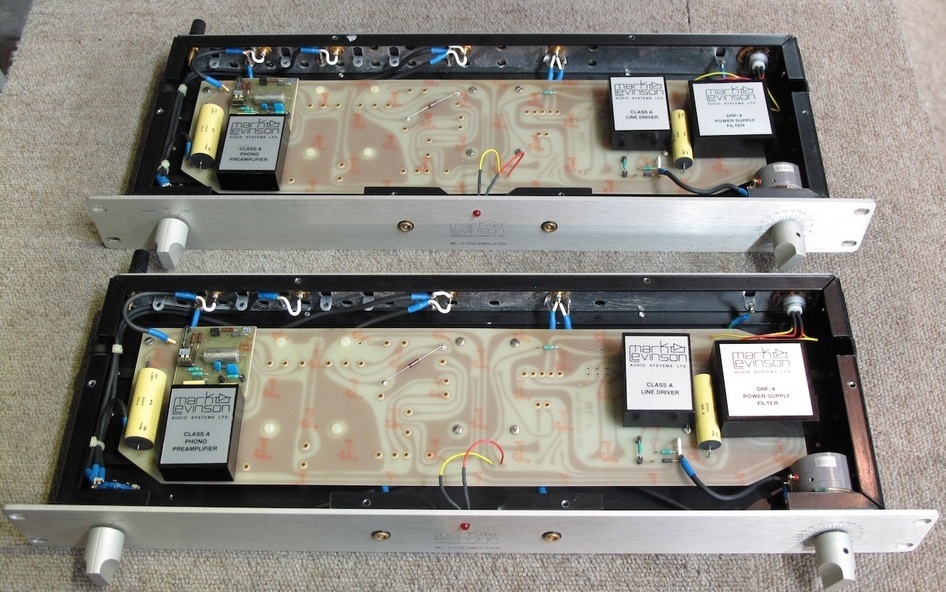
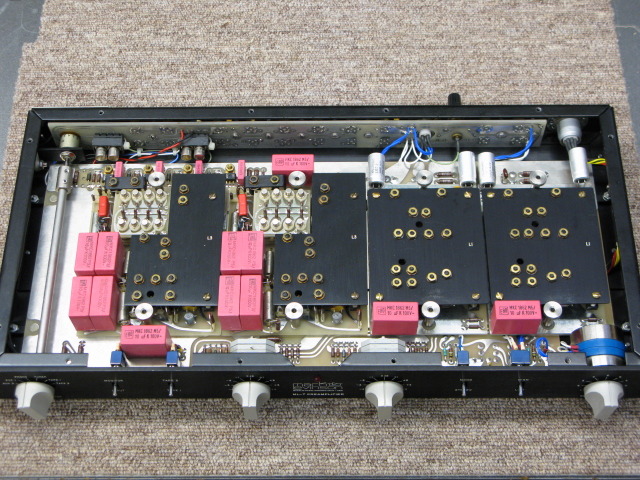
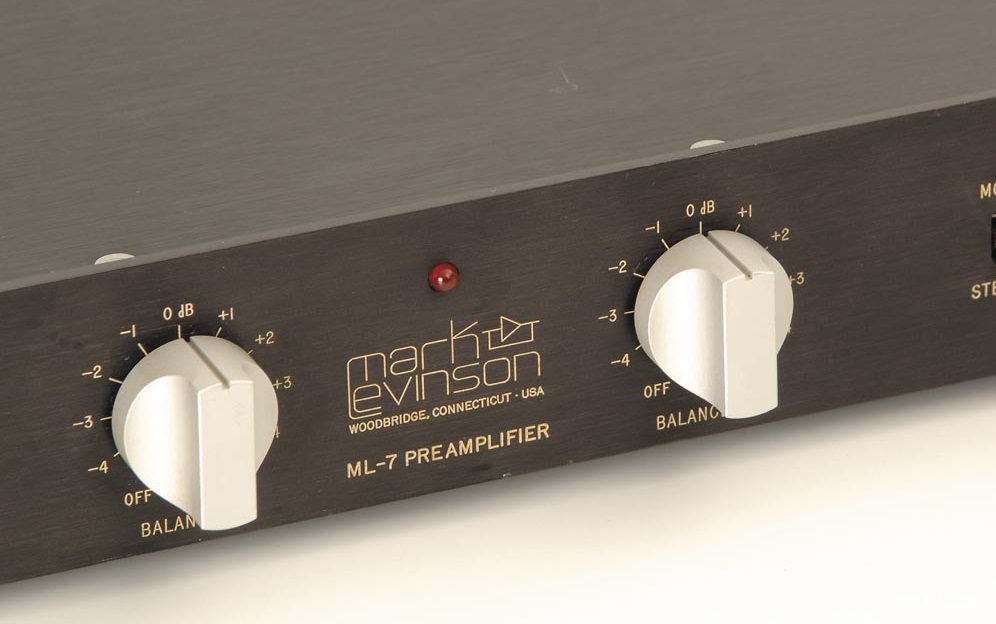
ML-7
1980 - 1985
By 1980, the potted-module type of circuit design had reached its ultimate potential and was replaced with the ML-7: new kind of two-channel preamplifier.
Widely regarded by the audiophile market as the new Mark Levinson standard of excellence, the ML -7 quickly set a new bar for sonic excellence and three-dimensional imaging.
ML-7A
1985 - 1989
ML-9
1981 - 1984
The ML-9 is a basic stereophonic amplifier with many of the features of the higher-powered ML-3. the ML-9 is rated at 100 Watts continuous sinewave power per channel into 8 ohms, with both channels driven, from 20 Hz to 20 kHz with no more than 0.2% Total Harmonic Distortion.
It will drive even the most inefficient loudspeakers to their full potential.
In fact, the ML-9 will easily satisfy the power requirements of all but the most unorthodox applications.
The design goal of the ML-9 was to provide the same overall performance of the Ml-3 in a component with about half the power, size and price.
Rated Power:
100 watts continuous sine-wave power pre channel into 8 Ω
Weight: 29,48 kg (65 lbs)
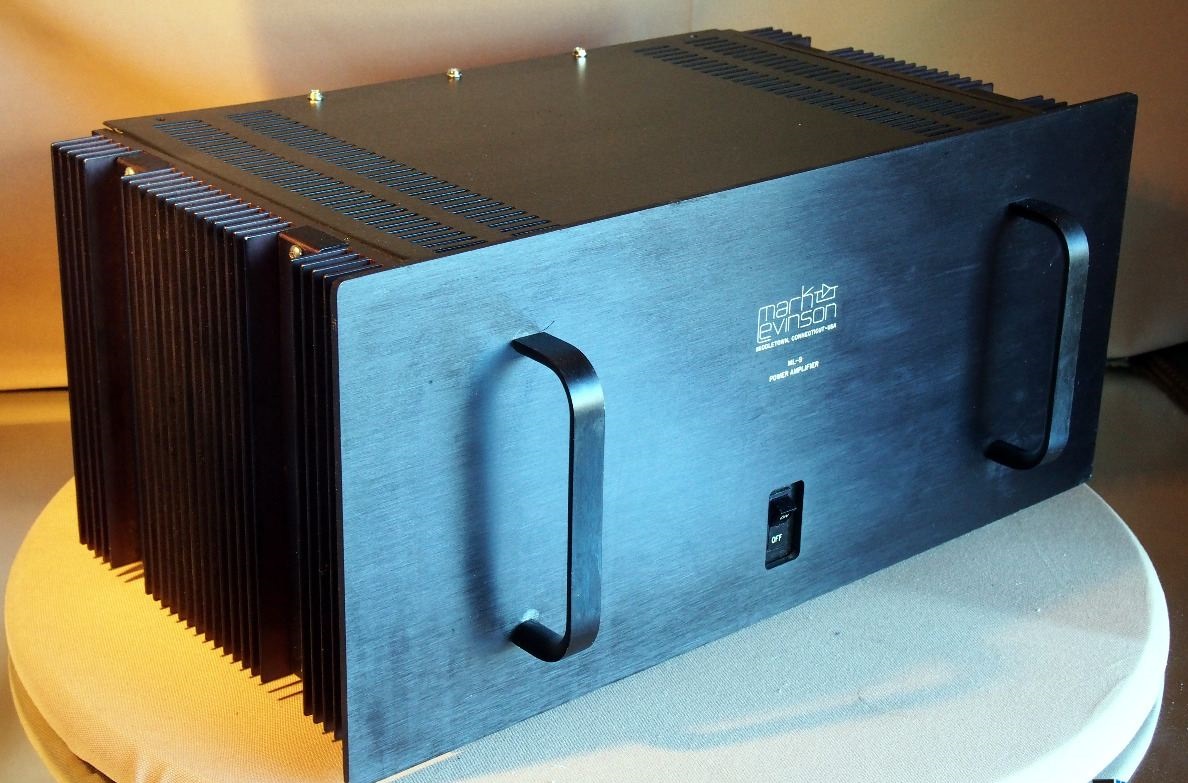
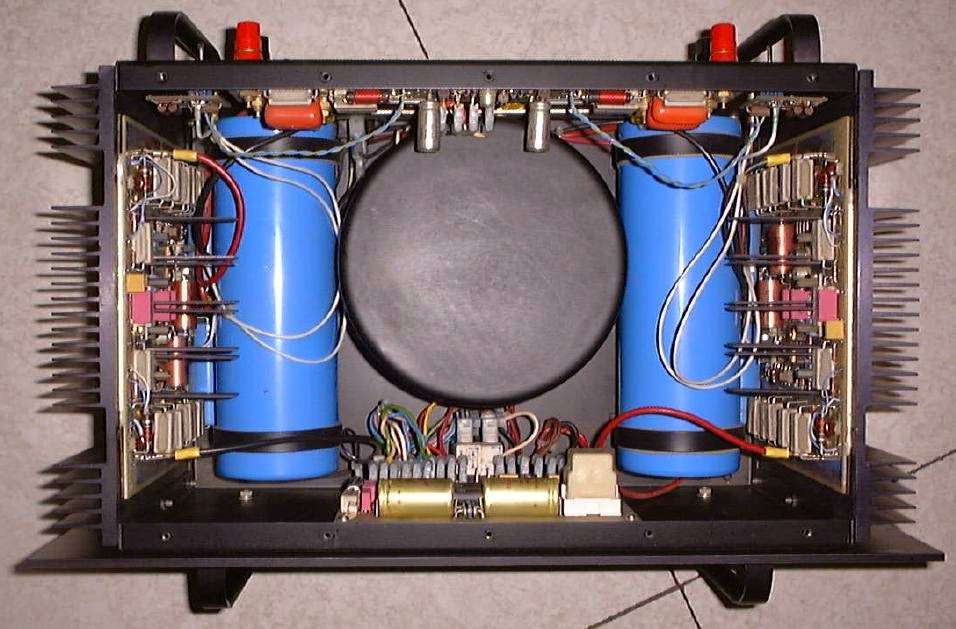
ML-10A
1981 - 1984
The ML-10 took all the knowledge from the JC-1 up to the ML-7 and incorporated it into a new design.
The Chassis ans looks are very much like their ML-1 and JC-1 but with improvements in quality.
It was outfitted with a very good phono stage. Settings were done on the inside.
The ML -10A preamplifier and ML -9 amplifier stand about midway in the hierarchy of Mark Levinson Audio Systems (MLAS) components.
Both are typical MLAS desogns, save that the ML -10A breaks with the company's tradition of separate power supplies for preamps, as its power supply has been successfully incorporated into its chassis.
Like all MLAS preamps, the ML -10A is a no -frills design, with a minimum of amplifier blocks or switches in the signal path
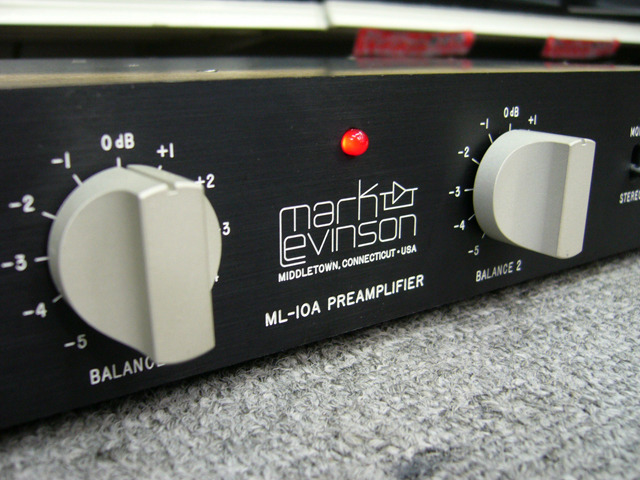

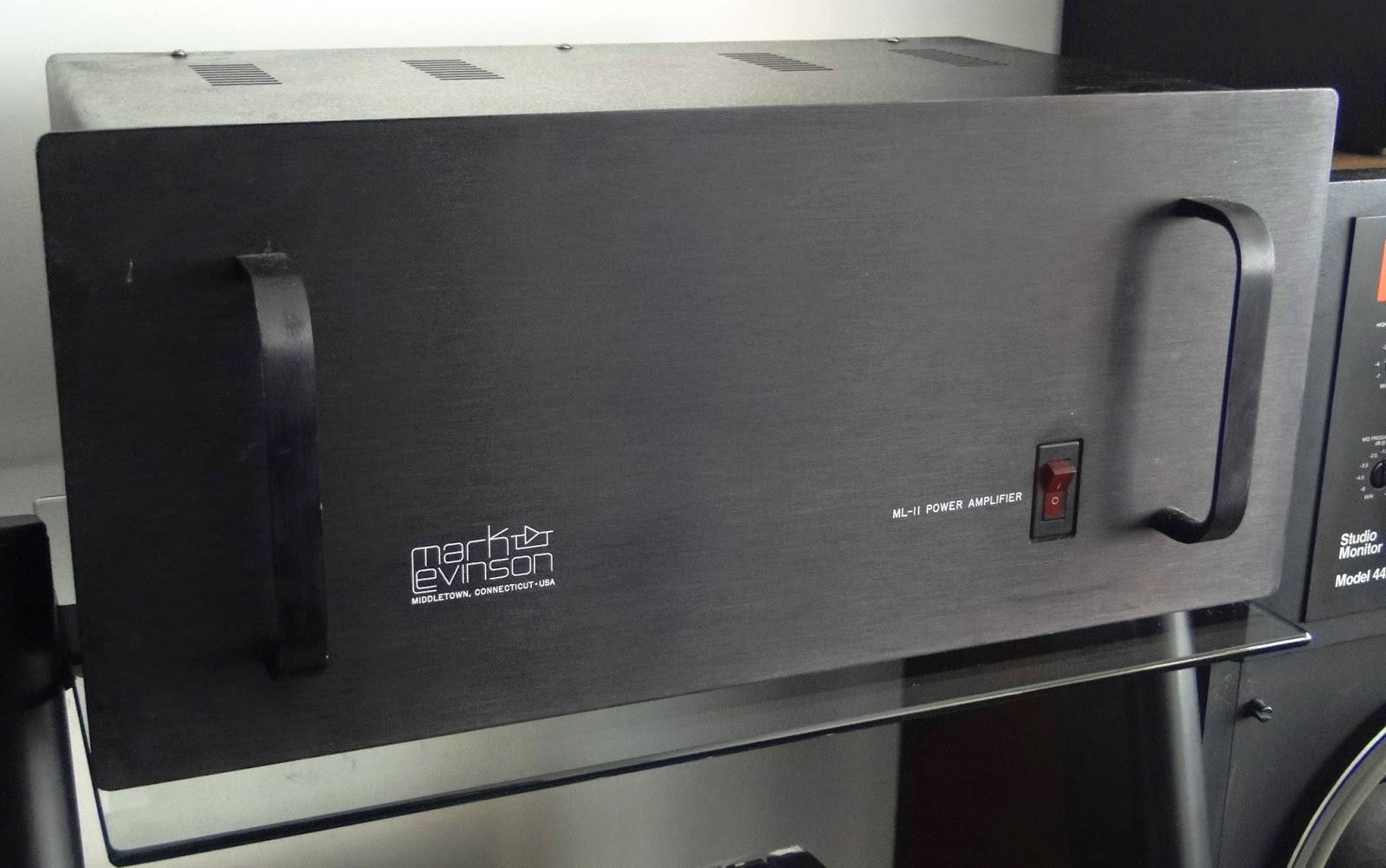
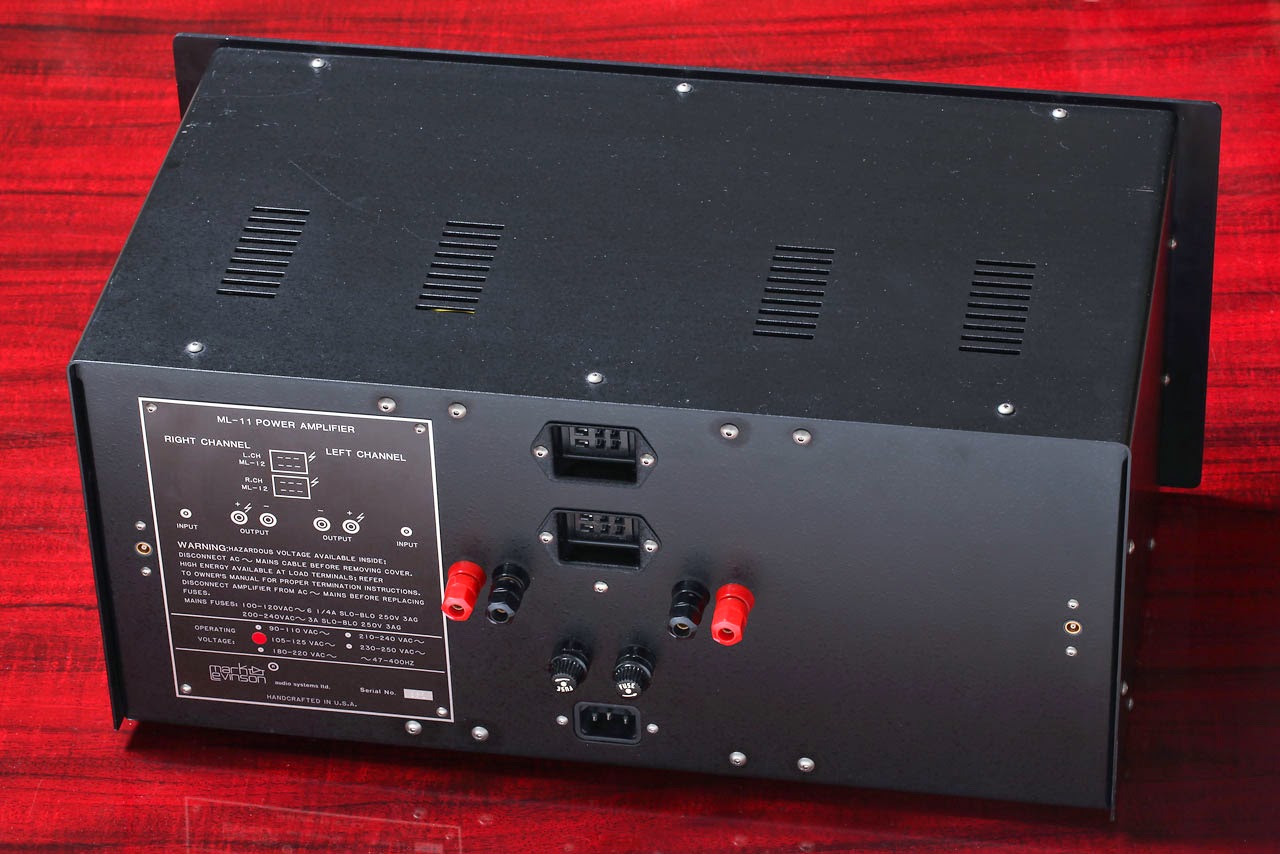
ML-11
1982 - 1989
With its 2 x 50W in a small enclosure with the heat sinks hidden inside makes it look shy, but it's not.
As with other models it can drive almost any load.
Specifications
Power output:
50W+50W (8 ohm, both channel drive, a succession sine wave, 20Hz - 20kHz, and less than THD0.2%) 140W (at the time of 8 ohms and bridge connection)
Weight: 11Kg
Maximum power : 260W.
The 50W/channel ML-11 power amplifier was designed to be paired with the ML-12 preamplifier (1984-1984)' later upgraded to the ML-12A (1984 - 1988)
This amplifier was the smallest an cheapest one.
With its 2 x 50W in a small enclosure with the heatsinks hidden inside makes it look shy, but it's not.
It another great amplifier of MLAS which is perfect as an all-purpose home hifi amplifier.
As the others he can drive almost any load.
The ML-12 preamplifier usually comes with it. And this is quite unusual: the ML12 takes his power from the ML-11 through a complicated multiple pins connector located at the rear of the ML-11.
ML-12
1984
ML-11 and ML-12 were Levinson's attempt at "affordable" components.
The fancy all-anodized aluminum housings gave way to simple painted steel, and the preamp's power connectors were industrial-looking Jones connectors, not Fischer.
Less flash, but still very well made.
The preamp gets it's power via a pair of umbilical connections to the power amp, though I could have sworn that Levinson eventually offered a dedicated power supply for the preamp.
New, they were something like $3K for the set back in 1986 or thereabouts.
Phone amplifier: 42dB, 53dB, 63dB (it changes with an internal switch)
Line amplifier: 6dB Input impedance
Phone amplifier: 50kΩ (switched by internal loading socket)
Line amplifier: 30kΩ Compatible load impedance
Phone amplifier (Tape out): 10 kΩ or more
Line amplifier (Main out) 10 kΩ or more
Power consumption 20W
External dimensions Width 483 x height 51 x depth 248 mm
Weight 4.5 kg
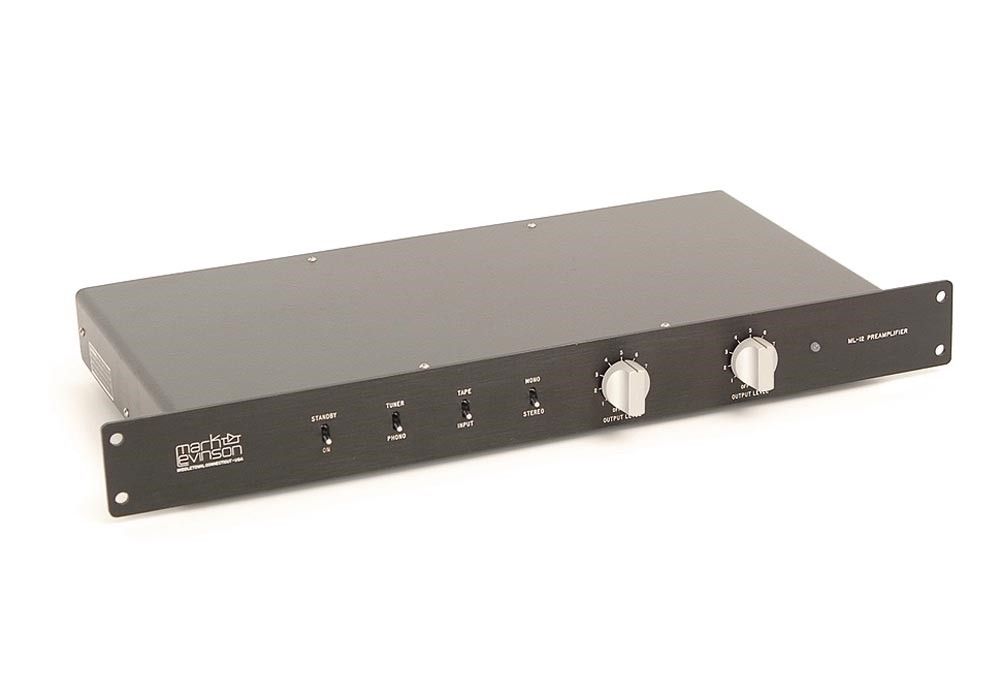
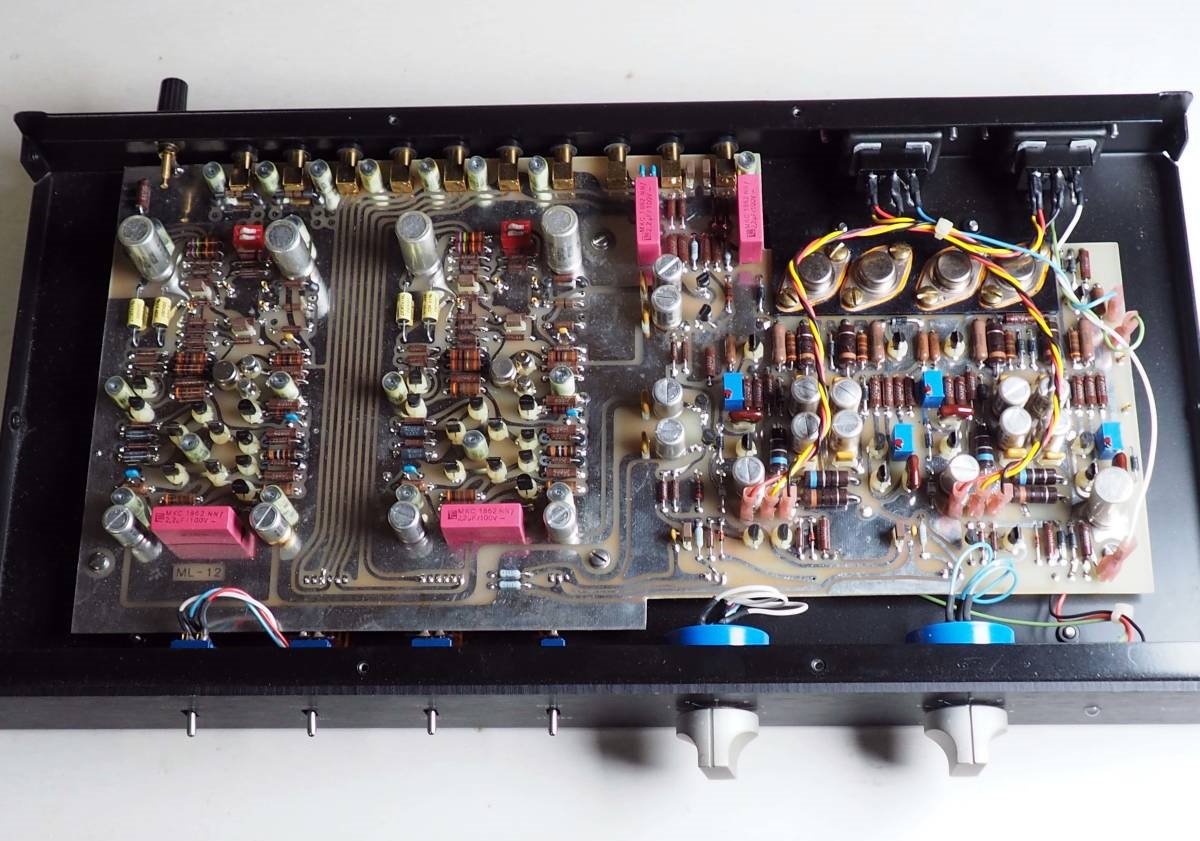

The Madrigal Years
When purchased by Madrigal audio laboratories, Mark Levinson was able to combine staffs to bolster already world-class industrial-design and product-design teams.
The partnership was directly responsible for some of the brand’s seminal products
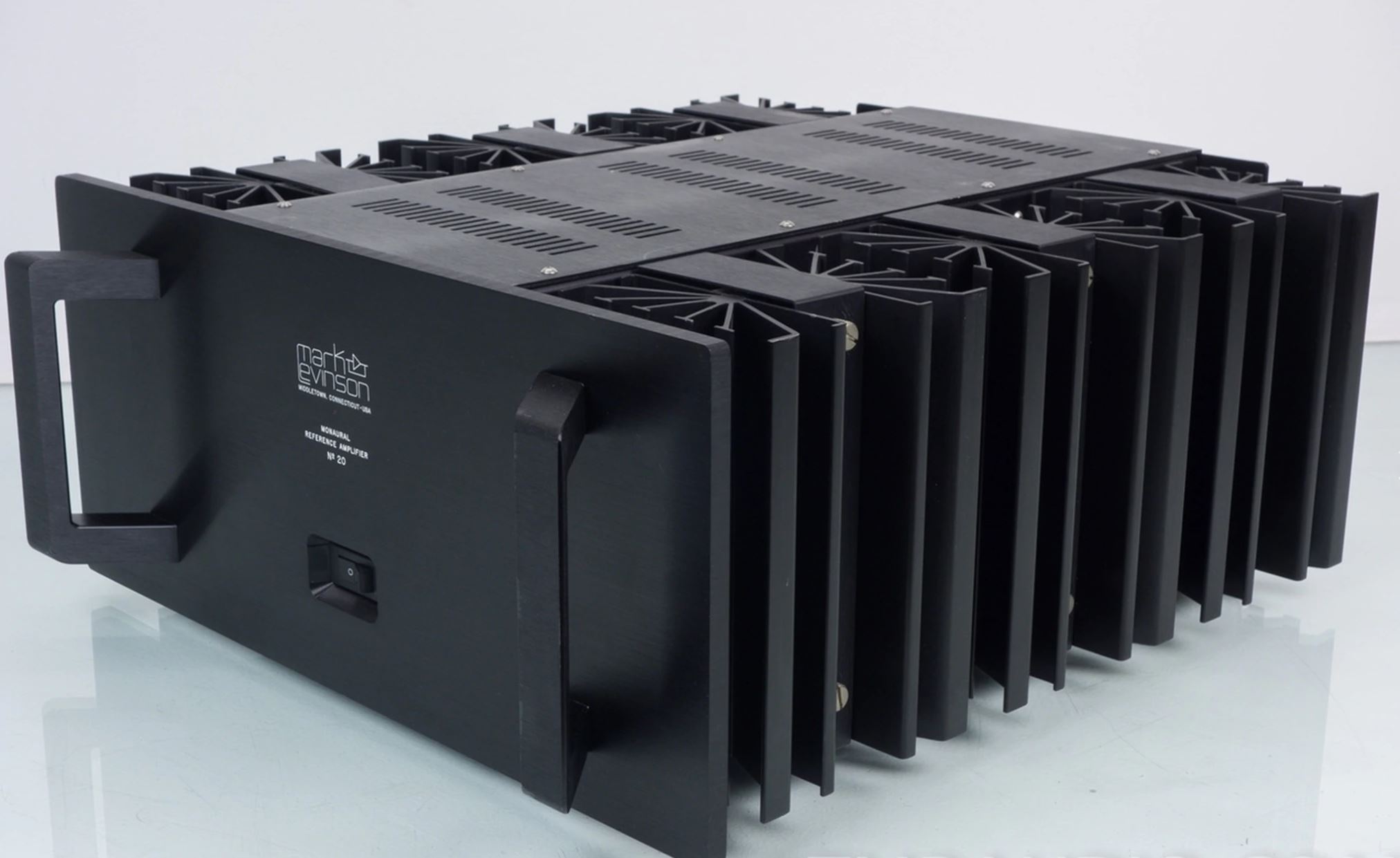
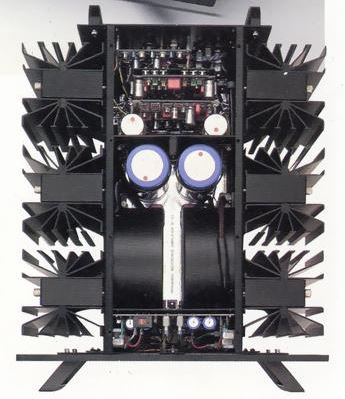
№ 20
1986
Soon after Madrigal bought Mark Levinson, the company began developing the new 100-watt-per-channel № 20 Monaural Power Amplifier.
The № 20 Series offered flawless operation and perfection in sound quality that more closely resembled tube amplifiers than the existing solid-state systems on the market.
Power:
100w into 8 ohm
200w into 4 ohm
Weight 33kg.
№ 20.5
1988-1989
The Mark Levinson 20.5 is pure class A mono blocks
The main changed parts from No20L to No20.5L are enhancements of the circuitry in the input-stage-voltage amplification stage, and a circuit element, and one plug-in PC board (card module) is changed.
Output:
100W into 8 ohms (20dBW);
200W into 4 ohms (20dBW);
400W into 2 ohms (20dBW) (all continuous sinewave power,
20Hz-20kHz, with less than 0.4% THD/SMPTE and less than 0.2% IMD).
Continuous available current: 24A.
Damping factor: greater than 400, 20Hz-20kHz; 1000 at 1kHz and below.
Frequency response: 3Hz-140kHz, -3dB at 1W output.
S/N ratio: better than 80dB, unweighted, below 1W output.
Measured output impedance: 0.015 ohms at 1kHz.
Input impedance: 50k ohms in parallel with 1nF. Sensitivity (EIA): 141mV for 1W output into 8 ohms.
Voltage gain: 26dB.

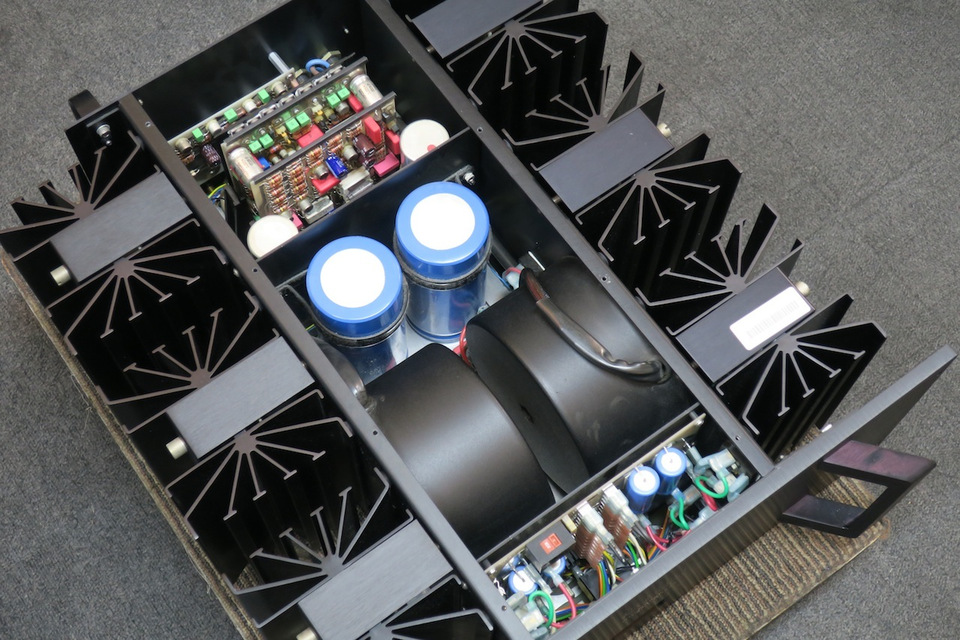
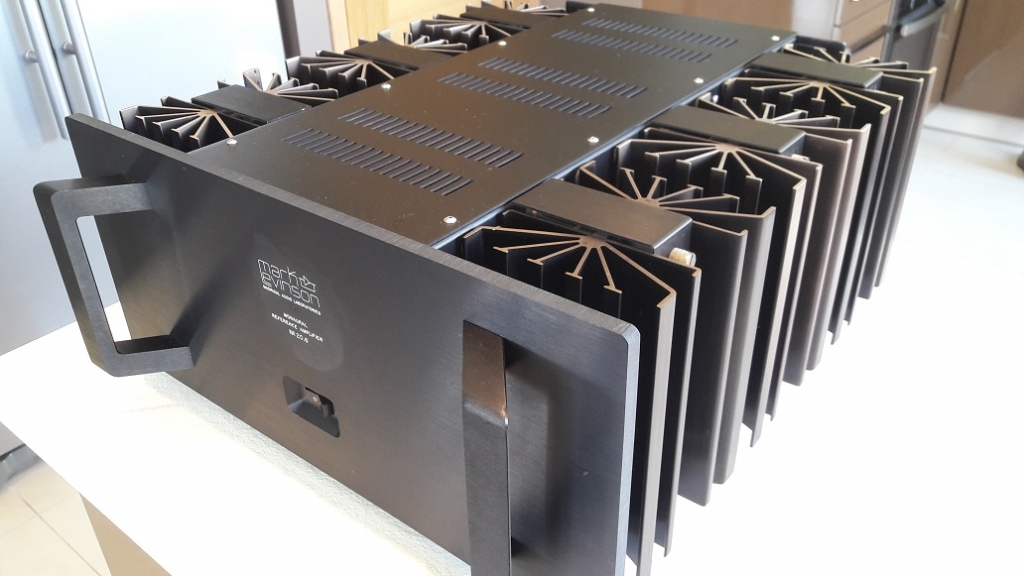
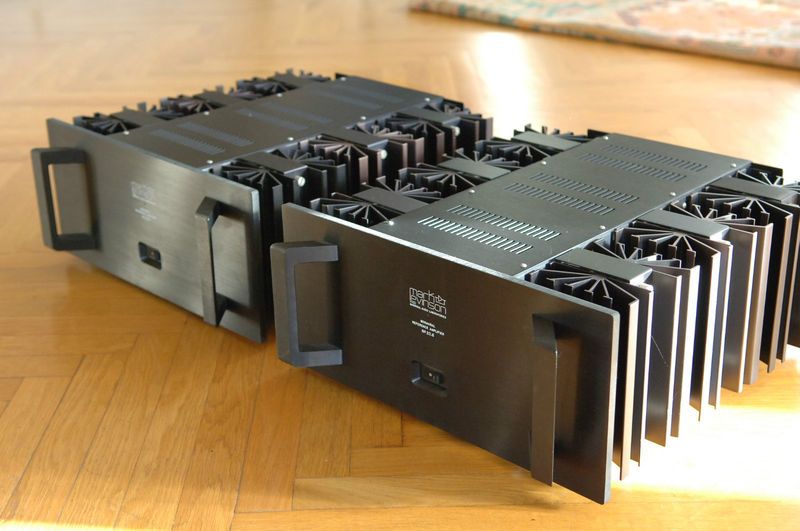
№ 20.6
1992
Top of the Line
Rated 100 watts/Amp Pure Class A with huge current
Owned and used by many top reviewers. John Atkinson bought a pair
"in my opinion, easily the most musically pleasing solid-state amplifier I have ever had the pleasure to use"
Power output:
100 watts per channel into 8Ω (stereo)
Frequency response: 4Hz to 140kHz
Total harmonic distortion: 0.2%
Gain: 26.9 dB
Dimensions: 444 x 478 x 209mm
Weight: 40.9kg
№ 23
1987
The No.23 was widely considered one of the greatest amps ever engineered and produced by Mark Levinson.
This is especially worth mentioning because the No.23 was produced when Mark Levinson still had full control of the company.
And what an amp this is. On paper, it had the specs most other brands lust for.
Supremely powerful at 200W per channel at 8 ohms and 40W per channel at 4 ohms and weighing a hefty 100lbs, this was no ordinary 200W amp.
The weight and authority it has over the music was simply mesmerizing. It has a sense of ease driving any of the speakers we have in the store.
Little wonder why this amp continues to be one of the most sought after amp.
The No.23 was manufactured from 1997 to 2003.
MSRP: 4,995.00
Power output: 200 watts per channel into 8Ω (stereo)
Frequency response: 20Hz to 20kHz
Total harmonic distortion: 0.3%
Gain: 26 dB
Input sensitivity: 0.141V
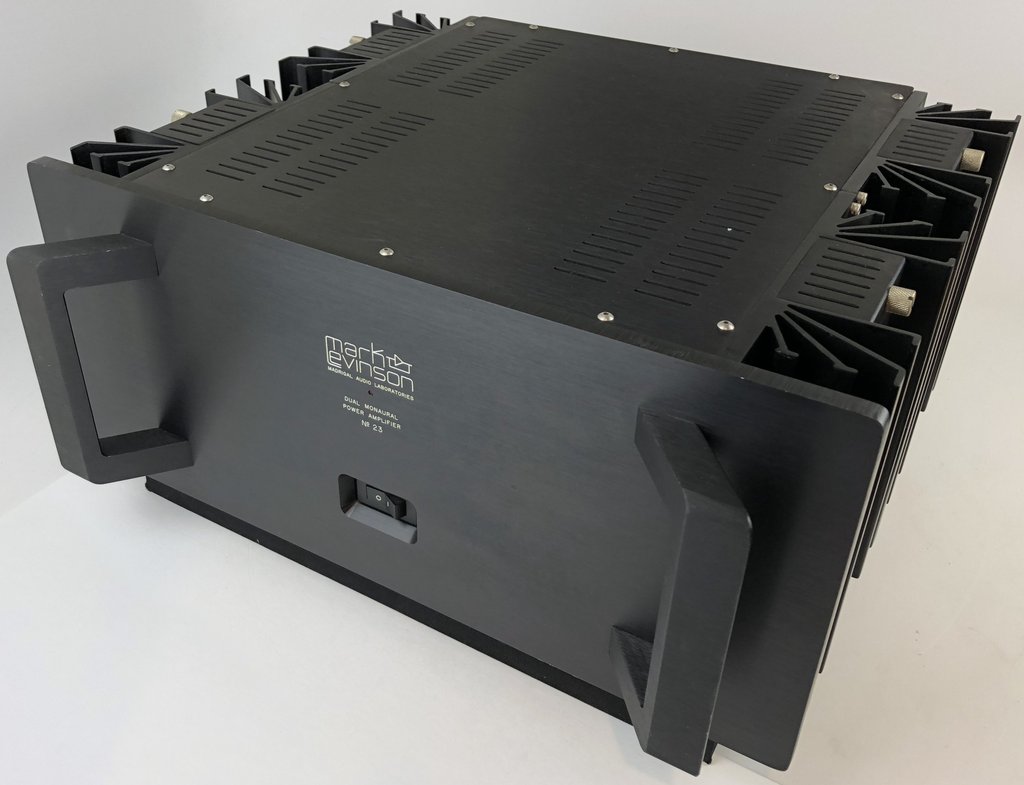
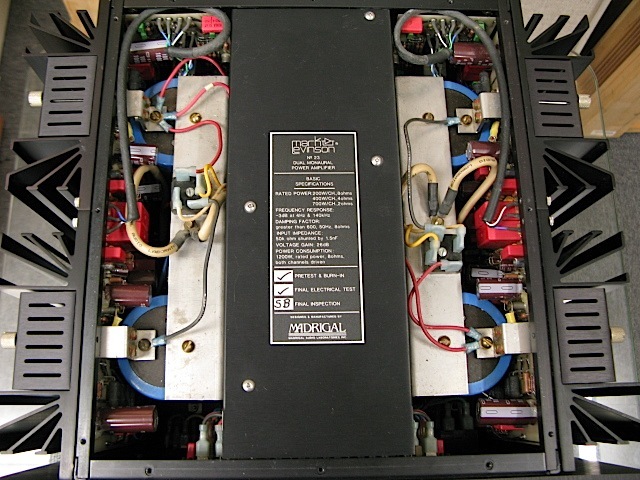
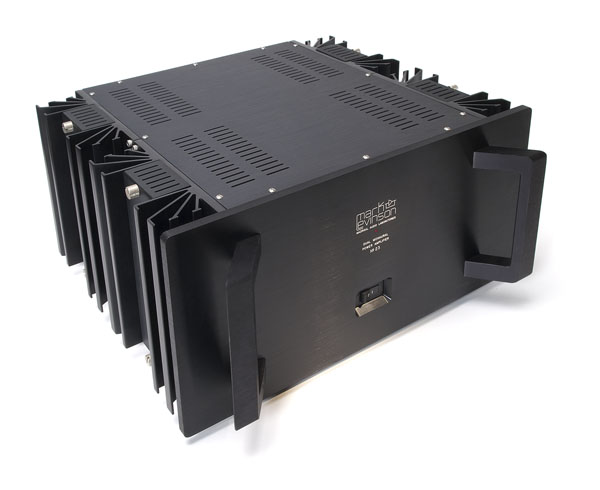
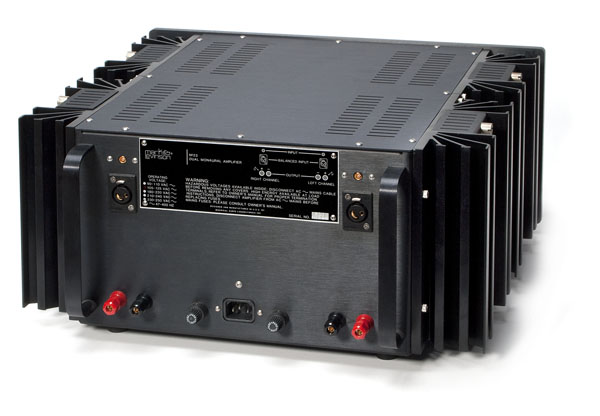
№ 23.5
1991
The no.23 was made from 1987 to 1990 and then became the 23.5, which ran all the way to 1995.
For a limited time, 23 owners could upgrade to the new model for about $2,000.
As much as hard-core Levinson fans will grump about which version is better, the truth is: they both really rock.
Though designed by the Madrigal staff (not Mark Levinson, the man), these amplifiers had a very musical sound that was considerably warm overall compared to later products that were more clinical sounding.
Compact in size compared to the monstrous blue Krell amplifiers of the same period, the no.23 was packed with power supply and output transistors bolted to massive heat sinks.
Don’t let the small size fool you; it still weighs almost 100 pounds.
he No.23.5 was an evolved reiteration of the highly successful No.23 amp.
With many notable changes and improvements, the No.23.5 was a more refined amp when compared to the No.23.
It shared the same 200W output (400W in 4 ohm) as before but delivers them in greater refinement and had a more smoother textured sound.
№ 25 & № 25s
1991, 1992
As many people claimed, this No. 25s (not No. 25) is probably the best phono preamp from Mark Levinson, ever.
The Mark Levinson 25 Dual Monaural Phono Preamplifier is a wonderful phono preamplifier.
it can be configured with two different levels of gain, and also offers a range of cartridge loading options.
The sound is classic Levinson - smooth as velvet with no real weakness. Specifications :
Power consumption : 20 Watts maximum, depending on options
Mains voltage : 220V, 240V AC @ 50-60Hz
Connector complement : 4 RCA-type connectors, nine-pin connector binding post (turntable ground)
Gain. :Selectable
Low-gain phono option : 38dB, 44dB
High-gain phono option : 58dB, 64dB
Input impedance : Selectable
Maximum output : 6 V
Recommended load : 10KOhm or greater
Dimensions(w x d x h) : 22 x 35 x 8 cm
Weight : 8 kg
Power Supply Unit Dimensions(w x d x h) : 19.5 x 35.5 x 8 cm
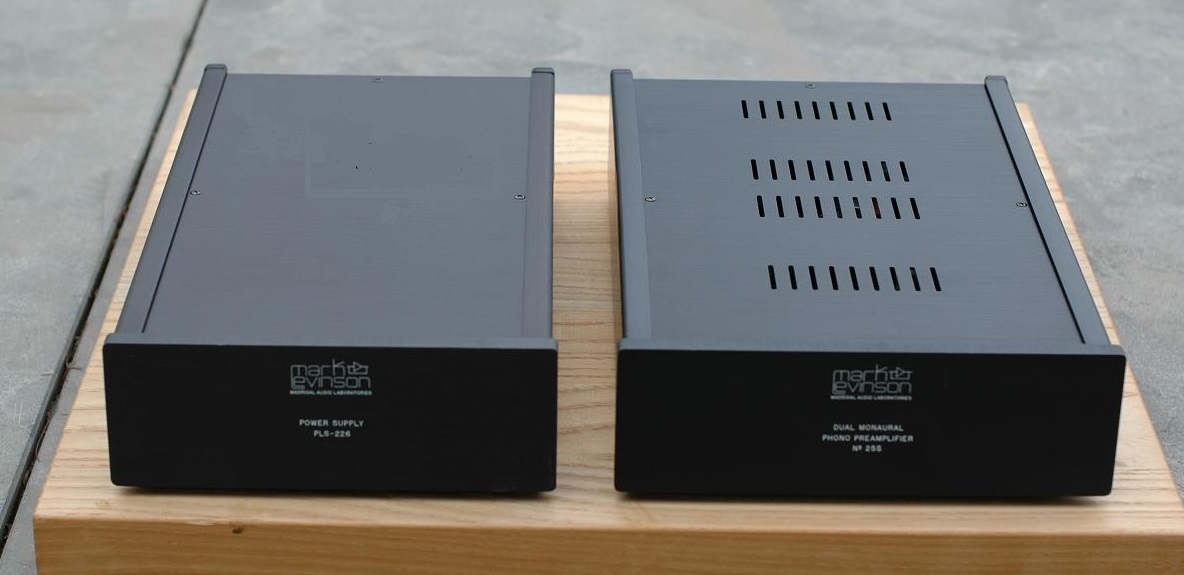
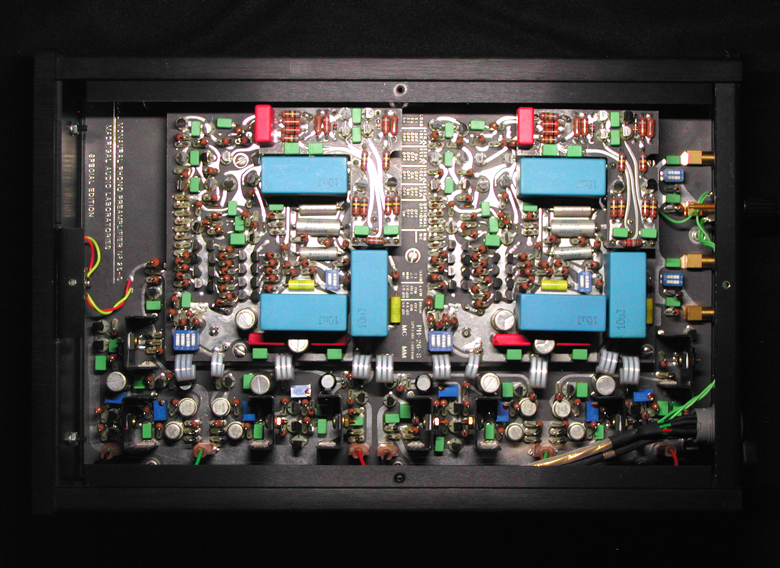
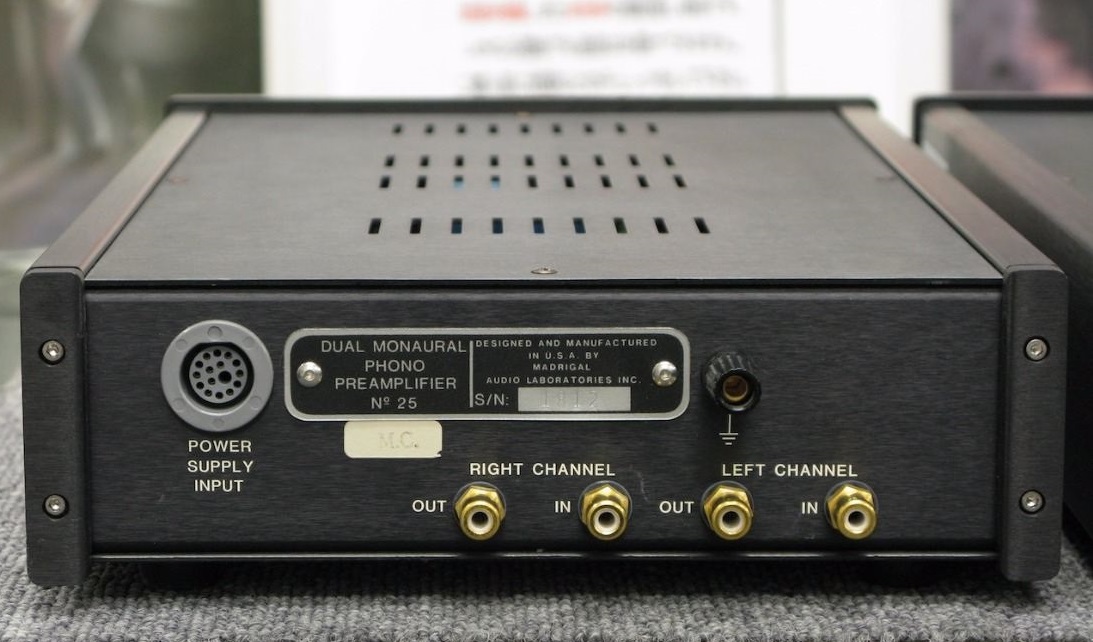
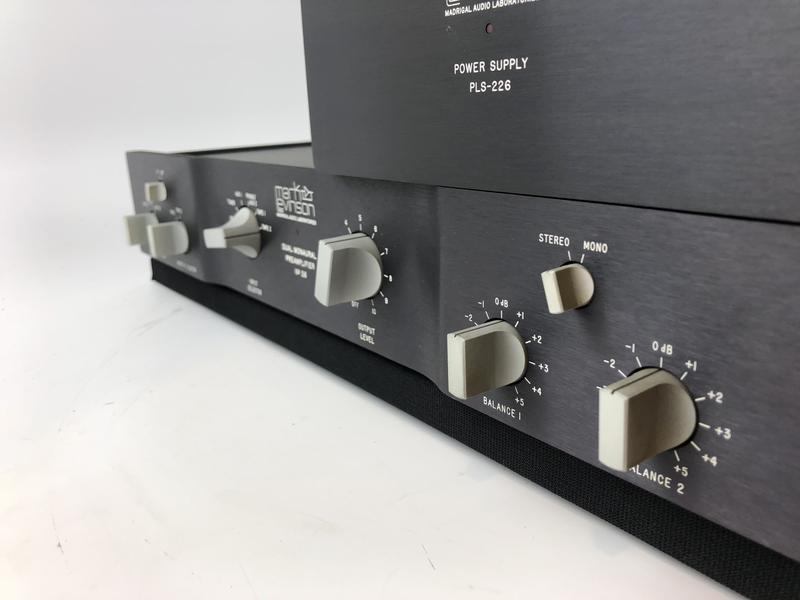
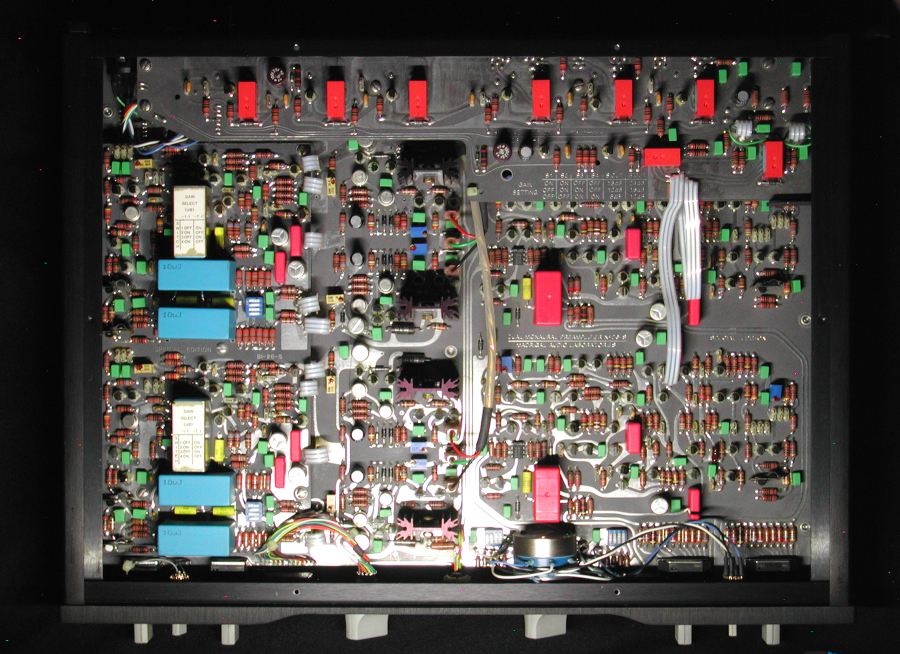
№ 26 & № 26S
1991-1994
The Mark Levinson No. 26S Dual Monaural Preamplifiers used Teflon circuit boards to supposedly differentiate the No. 26 and the 26S models, produced between 1991 and 1994 by Madrigal Audio Laboratories.
This unit utilizes Camac coaxial connectors (except for the XLR balanced ones), which were used in the medical industry as well, because they break hot before they break ground when unplugged.
No shorting electronics means a safe preamp and safe ER patients.
An external power block, the PLS-226, was used to keep interference to a minimum.
The No. 26S came in three versions, a balanced audio version, a phono version, and basic version that could do neither.
There was only space for one expansion board inside the unit, so it was not possible to put in the phono and the balanced board.
This made the phono and balanced inputs on the unit shared; only one set could be active in the unit based on which board was present.
- XLR Balanced Stereo Input and Output
- 3 Outputs: Main/Tape 1/Tape 2
- 6 Inputs: Tuner/Tape 1/Tape 2/CD/Aux 1/Phono or Aux 2
- 8 Selector knobs: Input/Output Level/Record/Monitor/Phase/Balanced 1/Balanced 2/Stereo, Mono
- Voltage can be adjusted internally: 100, 120, 200, 220, 240 VAC @ 50–60 Hz
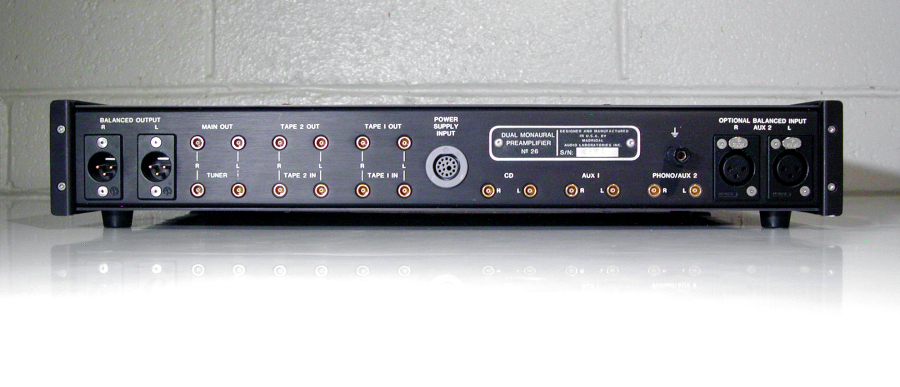
№ 27
1991-1994
The No.27 was one of the few amps that were always benchmark upon when reviewers were reviewing the sound quality of other power amps back in the late nineties and early years of this century.
Noted for its transparency, speed and tightly defined bass, the No.27 was a clear favorite amongst audiophiles for its sound and more so for its affordability.
Stereo power amplifier developed based on the know-how acquired in the development it1 of No23L.
The dual monophonic stream composition which separated right and left from the power transformer completely is adopted.
Two toroidal transformers and a total 45,000micro F capacitor are thrown into a power-source
Output power
350W+350W (2ohm)
200W+200W (4ohm)
100W+100W (8ohm)
700W (at the time of 4 ohms and bridge connection)
400W (at the time of 8 ohms and bridge connection
Weight 31.5kg
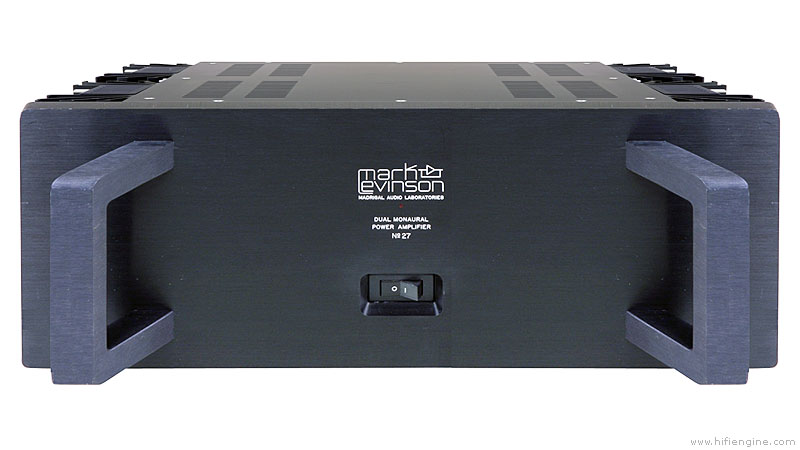
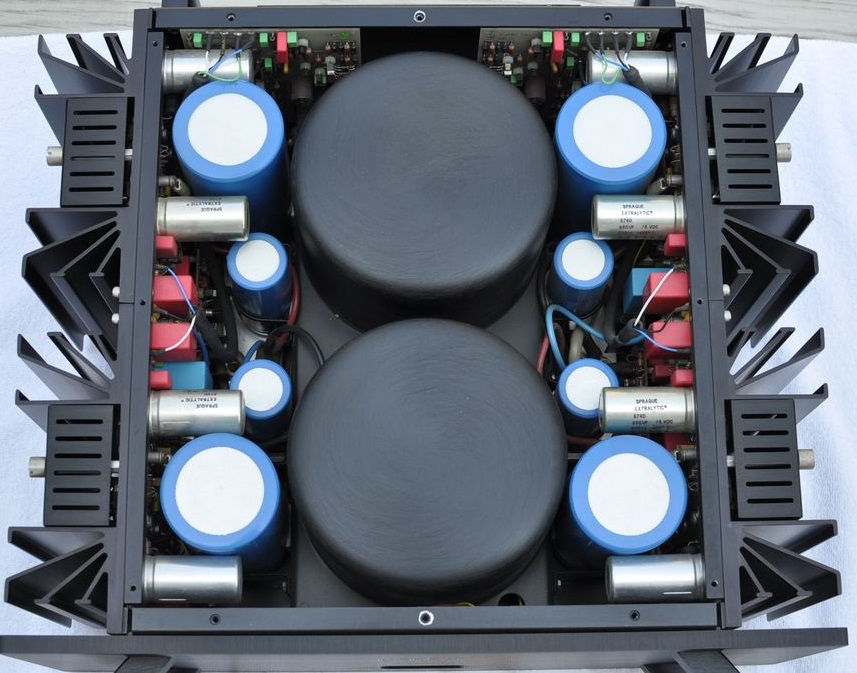
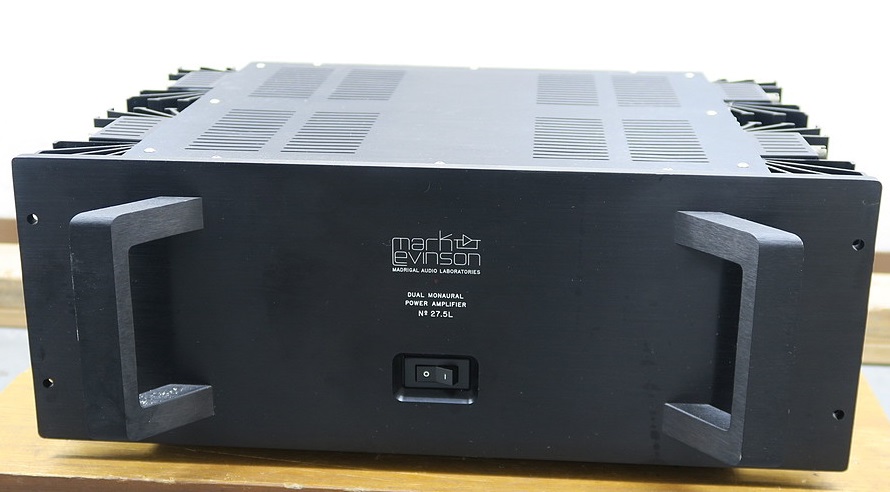
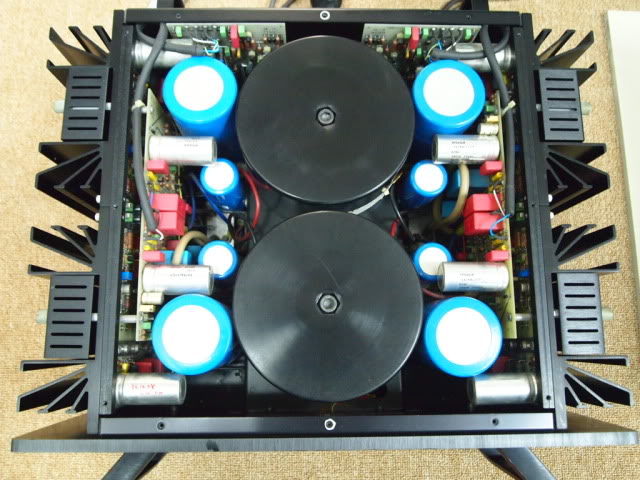
№ 27.5
1993
Mark Levinson 27.5 power amp.
Best sounding amp I've ever heard, and
These are 100 watts into 8 ohms, and make 400 into 2 ohms and are stable below 2 ohms!
Weighs 94 lbs, is an absolutely stunning amp.
This series of Levinson, is considered to be among the best, if not the best, and Made the Mark levinson name.
They cost almost $5000 new in USD back in 1992
Power output: 100 watts per channel into 8Ω (stereo)
Frequency response: 4Hz to 122kHz
Total harmonic distortion: 0.3%
Gain: 26.9 dB
Dimensions: 483 x 185 x 360mm
Weight: 43.1kg
№ 28
1989
This is another remarkable preamp from Mark Levinson that will not empty your bank account and is the more desirable RCA/XLR version and not the CAMAC/XLR version.
Power supply is kept separate in its own casing and can/should be kept far away from the main control unit.
The No.28 is a delicate preamp. It has the very distinctively clean and swift sound that is commonly associated with Mark Levinson preamps.
There is no remote control feature, there is not even and on/off switch
Price (RRP): £4000
Product Information:
Power consumption: 50W maximum, depending on options
Shipping weight (2 boxes):29 lbs. (13.2kg)
Connector complement:
16 female RCA-type connectors
4 XLR-type female connectors
2 XLR-type male connectors
1 binding post (for turntable ground)
1 ten-pin connector
1 IEC mains connector
Output impedance: 10Ω
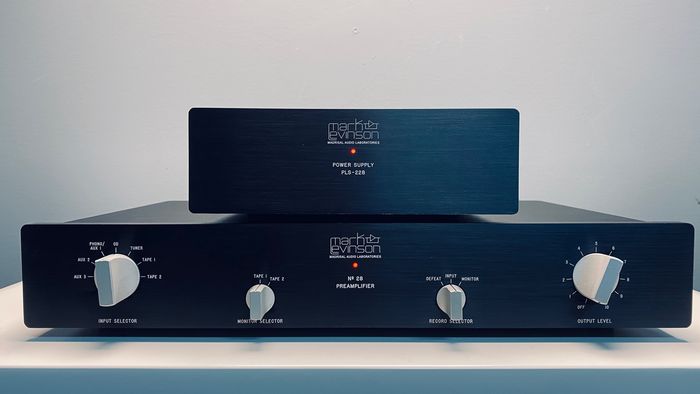
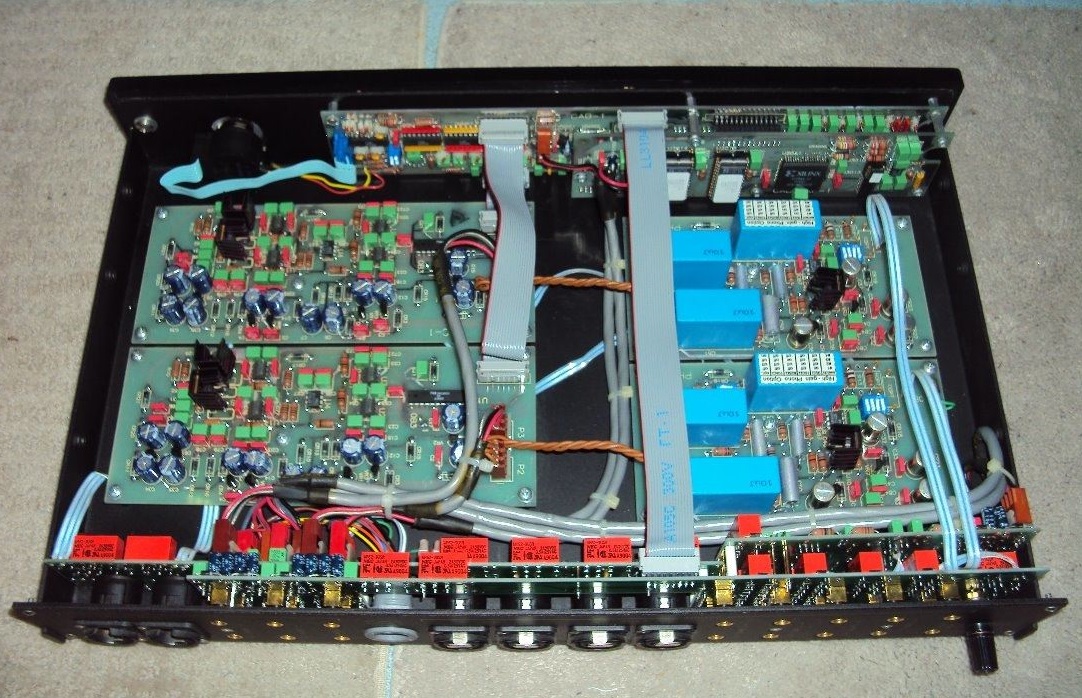
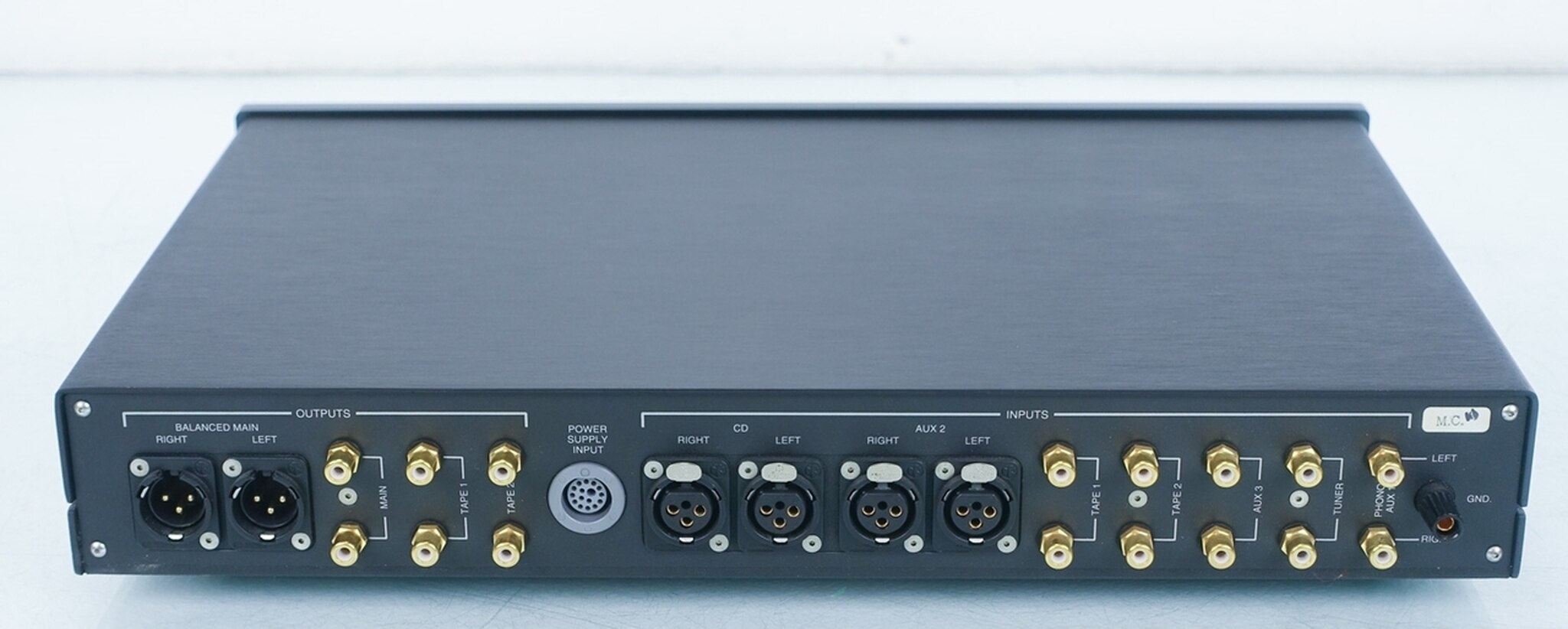
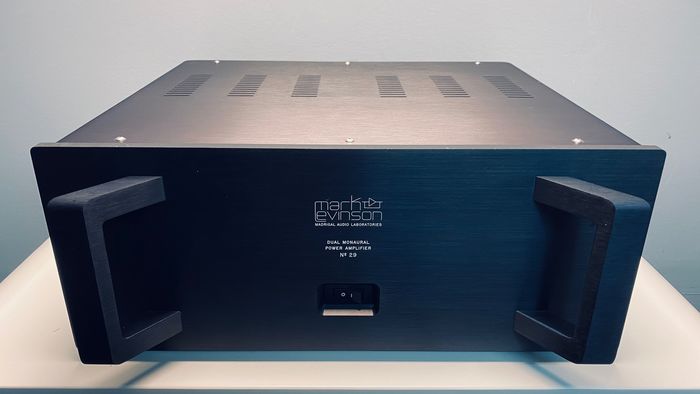
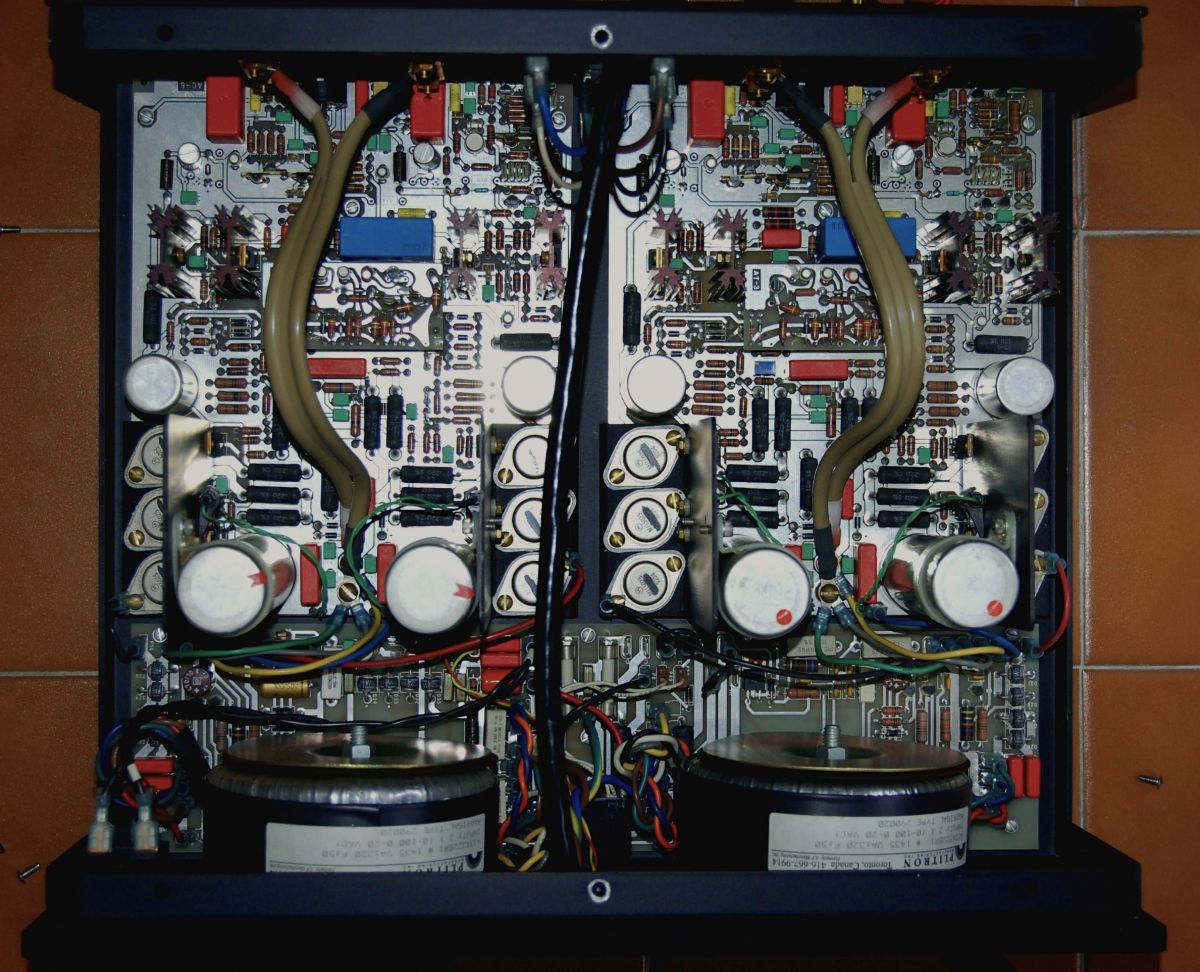
№ 29
1989
The Mark Levinson No.29 ($2800) is Madrigal's lowest-powered, lowest-priced amplifier.
Externally, it resembles their other power amps, though the huge heatsinks of the larger designs are missing—shrunk dramatically in size and banished to the inside of the chassis since they have an easier job to do with this 50Wpc design.
The only features of note visible on the outside, aside from the obvious power switch front and center, are the rear-panel jacks and fuses.
Solid-state stereo power amplifier.
Power output:
50Wpc into 8 ohms (17dBW),
100Wpc into 4 ohms (17dBW),
175Wpc into 2 ohms (16.4dBW).
May be bridged (for monoblock operation) into loads down to 2 ohms.
Rated THD: under 0.3% at rated power, 20Hz–20kHz.
Input Impedance: 50k ohms shunted by 1.5nF.
Voltage gain: 26dB.
Power dissipation: 100W (idle).
Dimensions: 17.5" W by 6.9" H by 14.6" D.
Weight (shipping): 60lbs.
Price: $2800
№ 30, 30.5. 30.6
1992-1999
The classic Mark Levinson № 30 Reference Digital Processor was instantly hailed as the new sonic benchmark and an achievement that signaled digital’s coming of age.
The companion № 31 Reference CD Transport completed the company’s goal to innovate the finest possible digital-playback system.
As a combination, the № 30 and № 31 were heavily praised as milestones in innovative design, technical execution, and sound quality, while exemplifying the company credo: better sound through real engineering.
In particular, the '30.5 introduced the concept of a FIFO (First-In, First-Out) buffer. Madrigal's design team introduced an HDCD upgrade kit for the No.30.5, consisting of the HDCD chip mounted on a small header board to replace the NPC chip.
Madrigal only had access to 96kHz material during the '30.6's development, so they didn't have direct experience of 88.2k sample rates (footnote 1). Nevertheless, when I fed the double-rate AES/EBU datastream from the dCS 972 to the No.30.6, "88.2kHz" appeared on its display.
Summing up: In its '30.6 incarnation, Madrigal's Reference Mark Levinson processor builds on its predecessor's reputation for state-of-the-art CD sound quality and adds high-sample-rate capability.
Other than a few DVD players with 96k data outputs, some computer soundcards, and pro recorders like the Nagra-D, such data sources are currently few and far between.
But with its "Reference" status assuring its owners that Madrigal intends to support the unit no matter what data sources become ubiquitous,
Frequency response: 10Hz - 20kHz +0dB, –0.2dB
■ Total harmonic distortion (THD): 0.001% @ 1 kHz, 0dB, A-weighted
■ Dynamic range: 98dB (or better)
■ Signal-to-noise ratio: 105dB
■ Channel separation: Better than 110 dB
■ Intermodulation distortion (SMPTE IMD): Less than 0.005%
■ Digital-to-analog conversion: Two custom 24-bit DACs
■ Digital filter: 16x oversampling
■ Analog filter: Bessel-tuned, linear phase to 40kHz
■ Low-level linearity: Deviation unmeasurable to below –70dB,
approximately +1.7dB below –90dB
(undithered, referenced to 0dB @ 1kHz)
■ Intelligent FIFO™ jitter: under 20 ps, uncorrelated
■ Output impedance: Less than 6Ω
“Dimensions”
■ Shipping weight (2 boxes): 89 lbs. (40.37kg)
■ Input complement, Nº30.6: 3 XLR-type female connectors
2 RCA-type female connectors
1 ST-type connector
2 EIAJ-type connectors
■ Output complement, Nº30.6: 2 pairs XLR-type male connectors (analog)
1 pair RCA-type female connectors (analog)
2 XLR-type male connectors (digital)
1 EIAJ-type connector (digital)
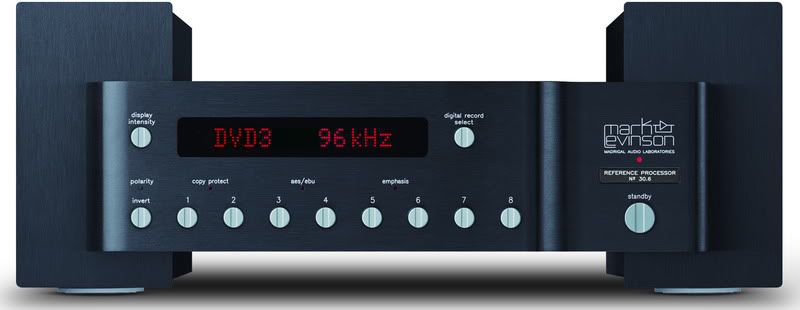
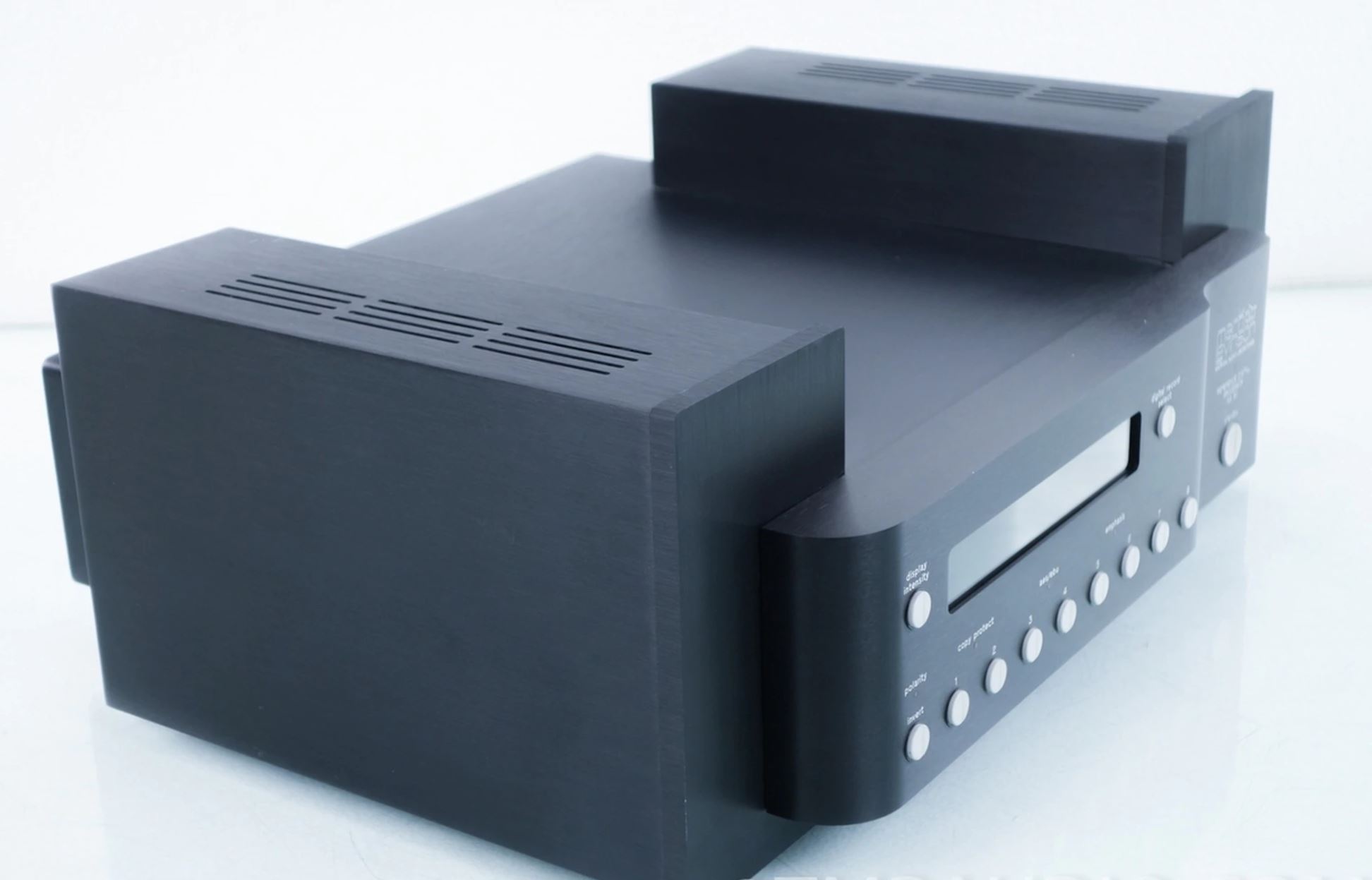
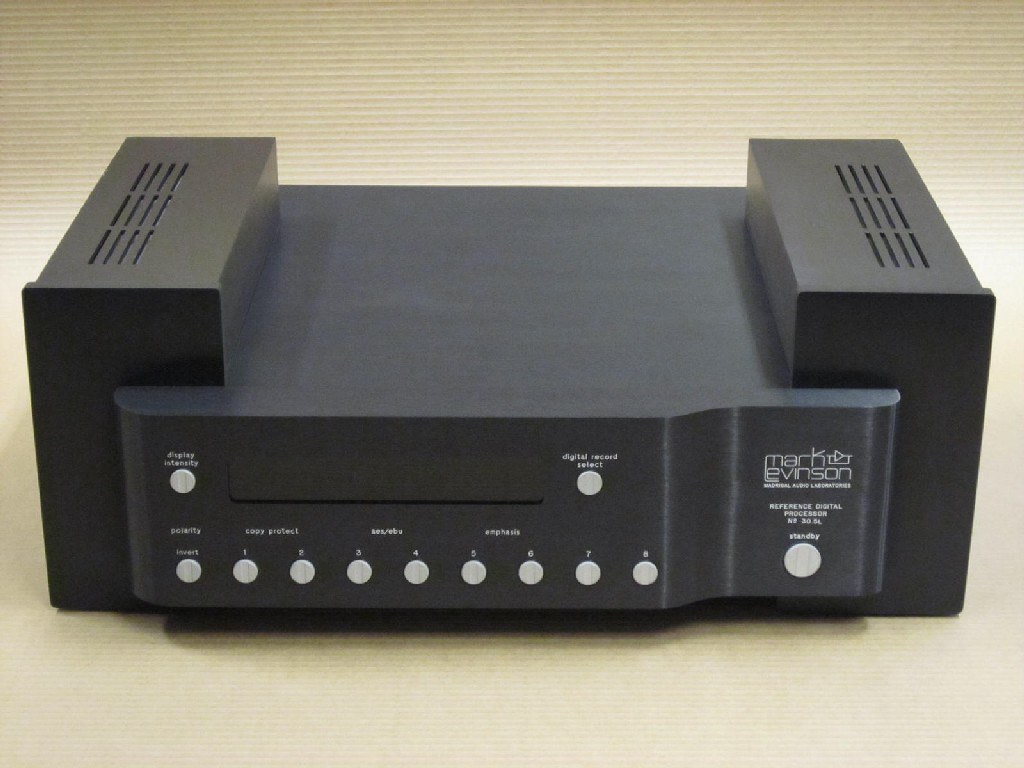
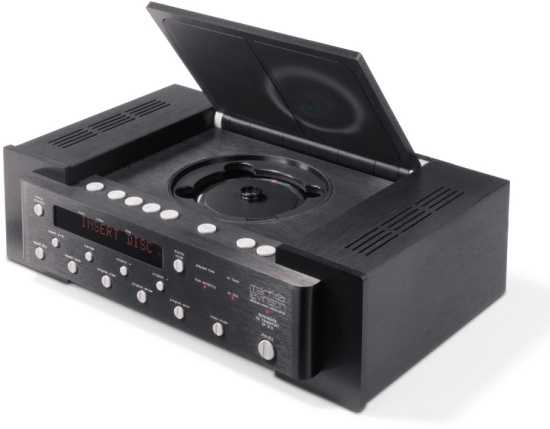
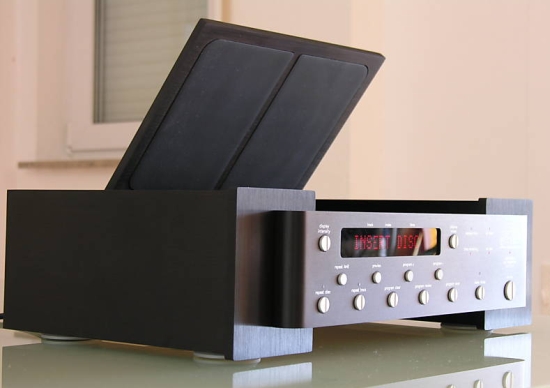
№ 31, 31.5
1992-1999
But this thinking was turned on its head after I took one listen to the new Mark Levinson No.31 Reference CD Transport from Madrigal Audio Labs.
The $8500 No.31, a Herculean design effort on the level of the Mark Levinson No.30, made a larger single difference to my playback system than almost any other component.
This was as true with the transport used to feed state-of-the-art processors (the Levinson No.30 and Meitner IDAT) Conclusion
Just as the Mark Levinson No.30 Reference Digital Processor set a new standard in digital to analog conversion, so too has the No.31 Reference CD Transport redefined CD transport quality.
It proved to be as revelatory as the No.30. I am at a loss to criticize the No.31. It produced such a transformation of my system that the newfound musicality may have blinded me to its faults. More likely, however, it will take a transport of equal caliber to reveal the No.31's weaknesses.
For now, the Mark Levinson No.31 is unparalleled.
Single-play CD transport.
Outputs: one AES/EBU on XLR jack (110 ohms), one S/PDIF on RCA jack (75 ohms), one HP ST-Type optical (AT&T–compatible), one EIAJ (Toslink) optical.
Additional inputs and outputs: slave in and slave out (for communication with other Mark Levinson digital products).
Dimensions: 19.375" W by 5.56" H by 13.726" D (14.426" H with lid open).
Shipping weight: 62 lbs.
Price: $8495 (1993);
№ 32
1999
The first reference preamplifier, the № 32 was designed without compromise to offer the ultimate in sonic performance.
The reference designation is reserved for those Mark Levinson products that meet specific criteria, including the very highest level of performance, in terms of both subjective sound quality and objective measurement.
In essence, reference products define the state of technical art and the sum of the brand’s knowledge and design skills—they embody an unswerving quest for perfection.
The No.32 Reference preamplifier. Note that "Reference" moniker.
The No.32 is the first Mark Levinson preamplifier to carry such appellation.
They're not kidding. Except in the best gear, greater apparent detail is often thrust at the unwary listener as thin, bright, over-etched sound—although I'm bound to note that, in the High End, this is becoming far less the case than ever.
Compared to only a few years ago, outstanding performance is available for quite modest prices. (And kudos to the industry for the convergence of solid-state and tubed sound, if at varying levels of overall refinement.)
But despite its hewn-of-a-piece presentation, I was floored by one special characteristic of the No.32: the enormous amount of unforced information passing through its circuits, from the quiet between the notes down in the noise floor to the most impressive of crescendos, and from the deepest bass fundamentals through to the top of its treble extension.
As a result, of course, palpability—a quality I much prize—was much enhanced. In that way, the No.32 proved a rather intimate component: no secrets.
I had the sense that the floodgates were open, the signal flowing unimpeded, the quality of the source components allowed to pass through and reach me, utterly unmolested.
But when you shell out the long green for gear like the Mark Levinson No.32 Reference preamplifier, you get a product that delivers on that promise of More and Better like nothing I've heard to date—a true Reference product whose name matches its performance.
Bravo.
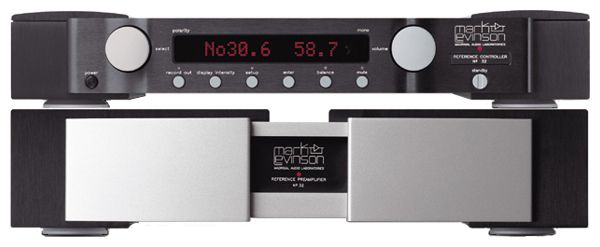
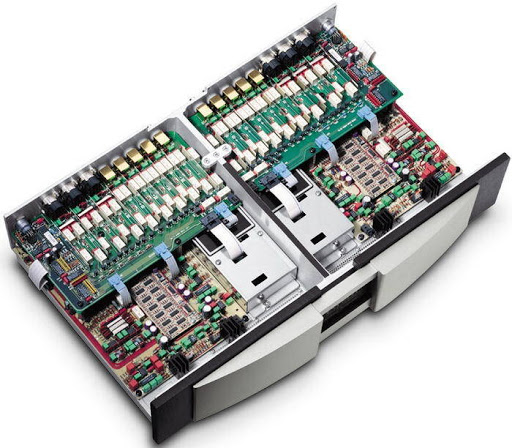
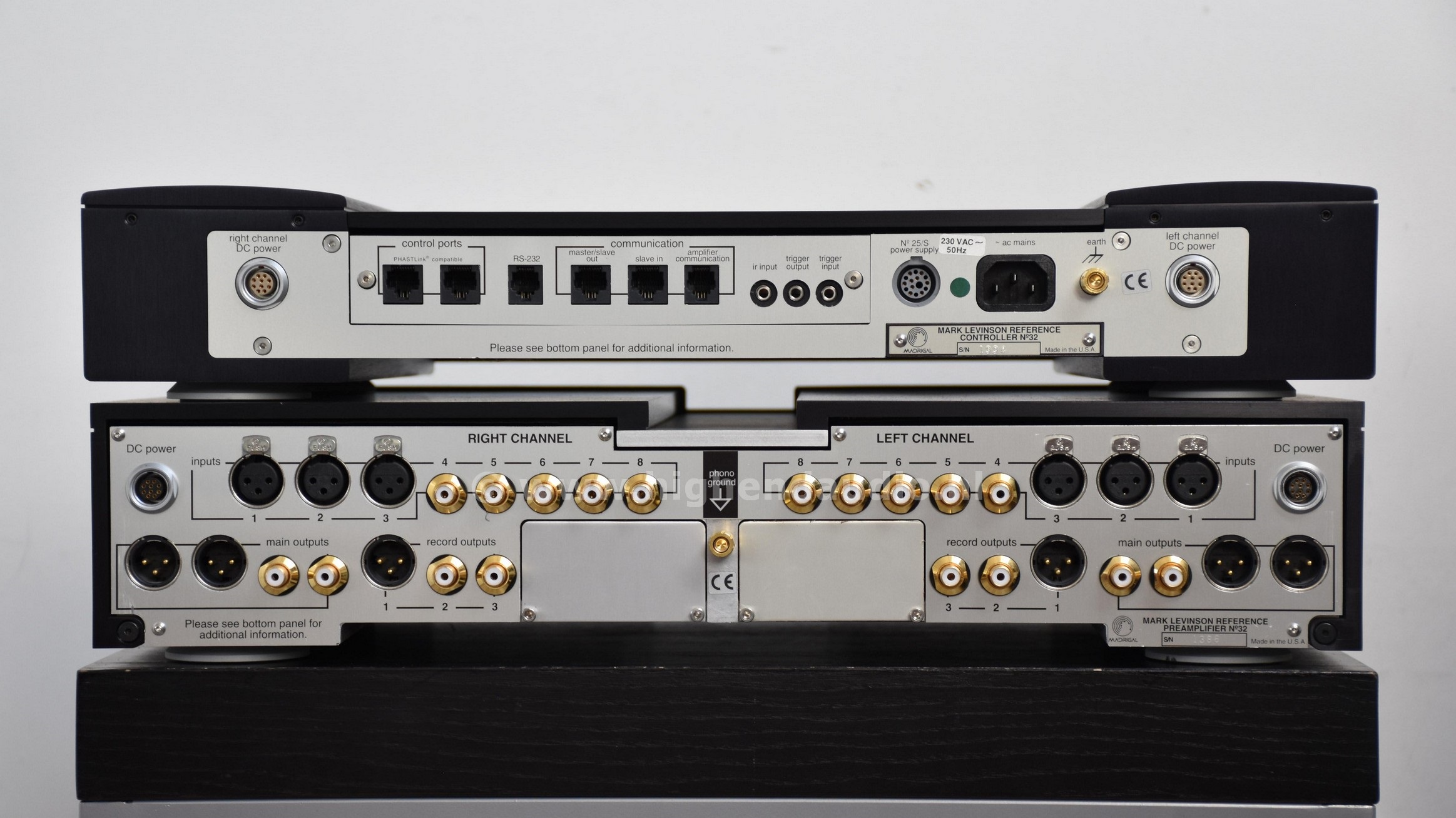
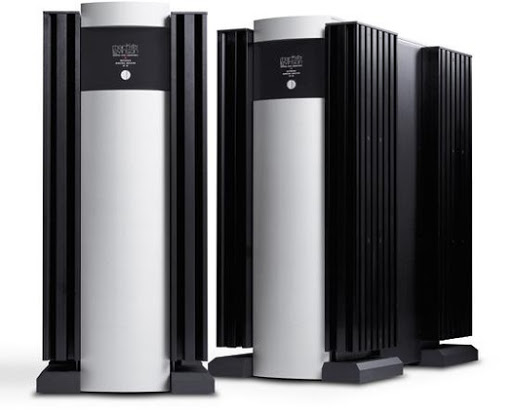
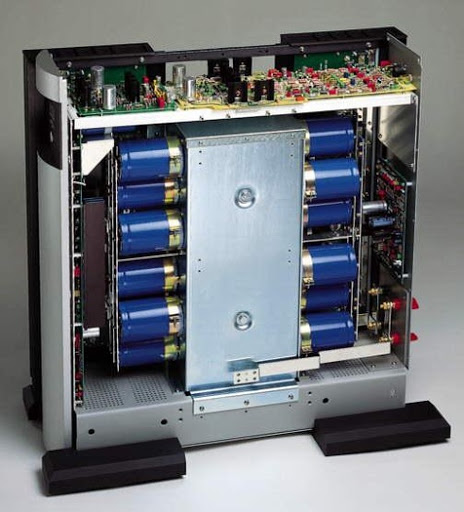
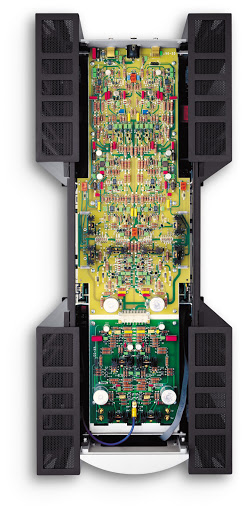
№ 33
1995
Operating in a fully balanced configuration, the Nº33 power amplifier was a huge technical development. Producing the highest power ever from a Mark Levinson product, it was deemed a new pinnacle of sonic achievement and became the basis for the forthcoming Nº300 Series.
The Nº33 Reference Mono Power Amplifier uniquely combines extraordinary power delivery with effortless control and unparalleled refinement.
Rated at 2,400W continuous into 1-ohm loads, it is the most powerful high-end amplifier in the world.
The Nº33 incorporates two 2.45 kVA low noise toroidal transformers in a fully balanced power supply. In this design, there is a separate power supply (each with its own power transformer) for both the inverting and non-inverting halves of the amplifier.
Twelve 39,000 μF low ESR capacitors are used in each amplifier. The power supply of each Nº33 provides almost 1⁄2 a Farad of capacitance and 1200 Joules of energy storage.
Heavy oxygen-free copper bus bars enhance the efficiency of power distribution within the amplifier and eliminate variances introduced by the wiring harnesses, etc. more commonly found even in high performance amplifiers.
High frequency power supply bypass is accomplished on individual PC boards by a total of 56 components of several film types. The resulting uniformly low power supply impedance seen by the various circuits within the Nº33 lays the foundation for both the massive power and the extraordinary finesse that characterizes this amplifier 2nd hand price: $15,500.00
Rated power output:
- 300 w/ch continuous rms power @ 8Ω
- 600 w/ch continuous rms power @ 4Ω
- 1200 w/ch continuous rms power @ 2Ω
- 2400 w/ch continuous rms power @ 1Ωall of the above power ratings measured from 20 Hz–20 kHz with no more than 0.3% THD
- Frequency response: within 0.1 dB from 20 Hz to 20 kHz
- Signal to Noise ratio (main outputs): better than –80 dB (ref. 1 w)
- Input impedance: 100kΩ (balanced) 50kΩ (single-ended)
- Voltage gain: 26.8 dB
- Input sensitivity: 2.3 V for full rated output
- Power consumption: typically 840 W (±5%) at idle, typically 210 W (±5%) in standby
- Mains voltage: determined by the needs of country for which the unit was manufactured; cannot be reset by dealer or user
- Overall dimensions: See “Dimensions”
- Shipping weight: 435 lbs. (198 kg) each
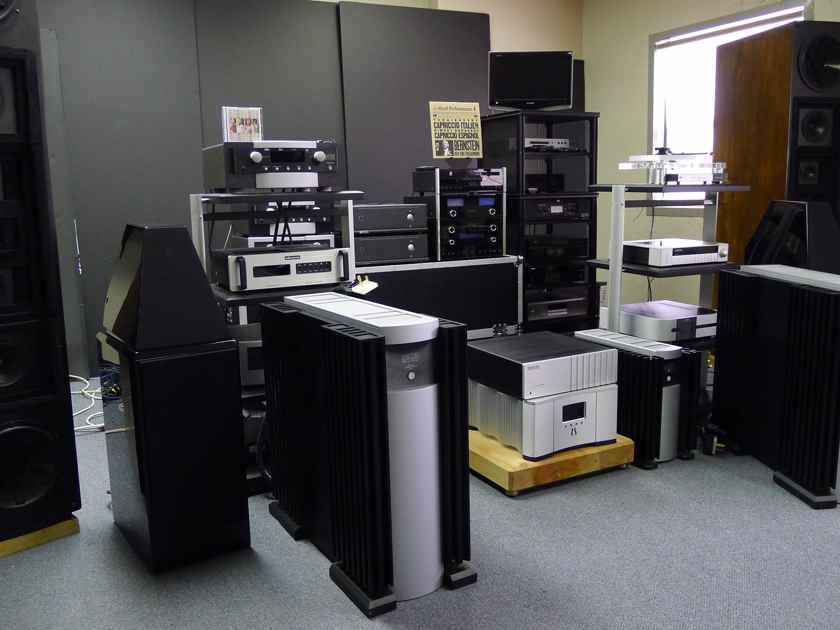
№ 33h
1998
Chances are you've never seen an amplifier quite like the Mark Levinson No.33H.
That's because there's only one other amp that's anything like it: the Mark Levinson No.33, upon which it's based.
Both amps are more tall than broad, looking almost as though they're resting on their ends; heatsinks cluster around their side-panels.
In the city of the High End, the No.33 and No.33H are skyscrapers standing tall above the warehouses.
When Madrigal first unveiled the No.33, they were drawing a line in the sand. "This is everything we know about building amplifiers," they said.
But they weren't prepared for the public's response to their No.33 Reference statement—at $33,000/pair, they figured they'd sell a few a month, but that there could never be that much demand for a heavy (well over 200 lbs), massive, 300Wpc monoblock.
They were wrong. "The response was overwhelming," said Jon Herron, head of product development at Madrigal.
The issue is one of truth in music, or more accurately, truth in recording.
I'm closer to the heart of the matter. More than ever before, a superbly resolved soundstage appears to exist independent of the hardware.
I've a better defined sense of depth, of coherence within the spread.
That elusive quality of soundstage height seems more discernible too.
I'm hearing a far more authoritative dynamic, an extraordinary control over transients, however crisp, brutal, or startling, along with a better delineated sense of dynamic gradation: diminutive sounds stand in clearer relief.
The huge amp's en-pointe finesse is perhaps what would most impress were it not for a no less forceful sense that the sounds one hears are unrelated to the electricity fueling these events.
Rated continuous-power outputs:
150W into 8 ohms (21.8dBW),
300W into 4 ohms (21.8dBW),
600W into 2 ohms (21.8dBW),
1200W into 1 ohm (21.8dBW).
Frequency response: 20Hz-20kHz, <0.5% THD. S/N ratio: better than 80dB (ref. 1W), better than 105dB (ref. full output). Input impedance: 100k ohms balanced, 50k ohms unbalanced.
Output impedance: <0.05 ohms, 20Hz-20kHz.
Damping factor: greater than 800 at 20Hz. Input sensitivity: 130mV for 2.83V output, 1.59V for full-rated output.
Voltage gain: 26.8dB. Typical power consumption: 540W ±5% at idle, 210W ±5% in standby.
Dimensions: 11" (279mm) W by 18.5" (470mm) H by 22.88" (581mm) D.
Shipping weight: 220 lbs.
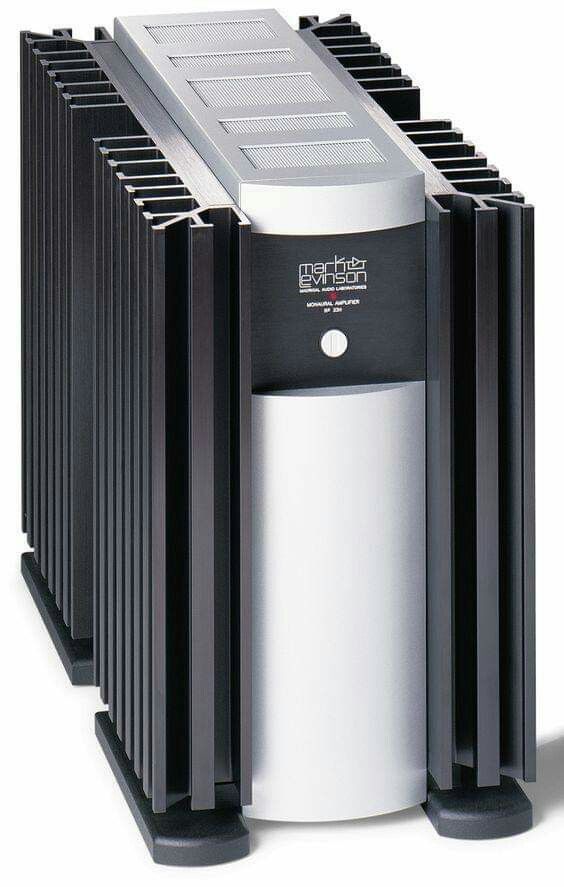

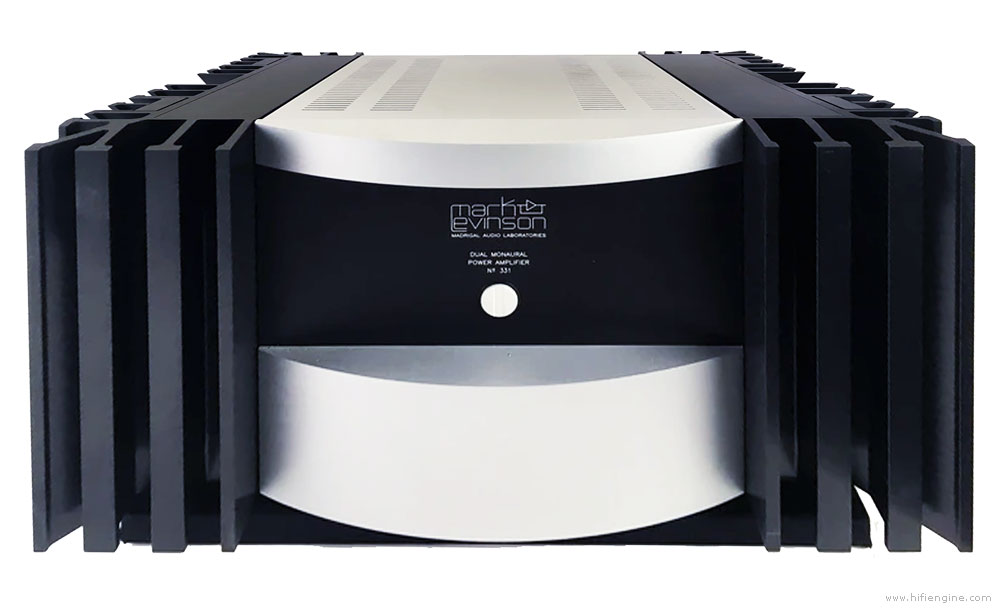
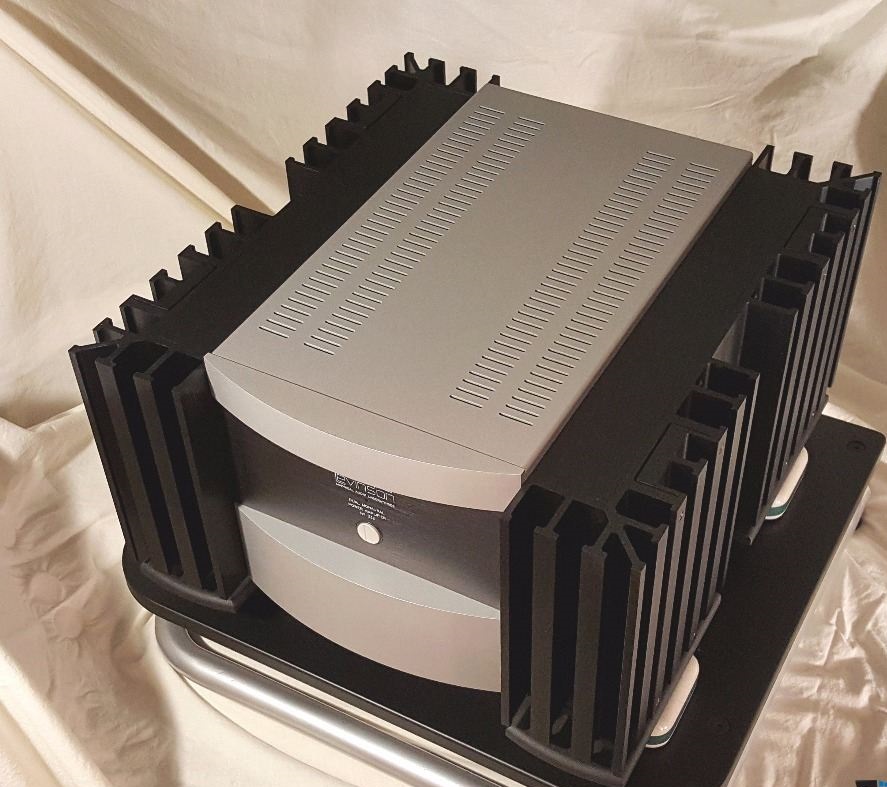
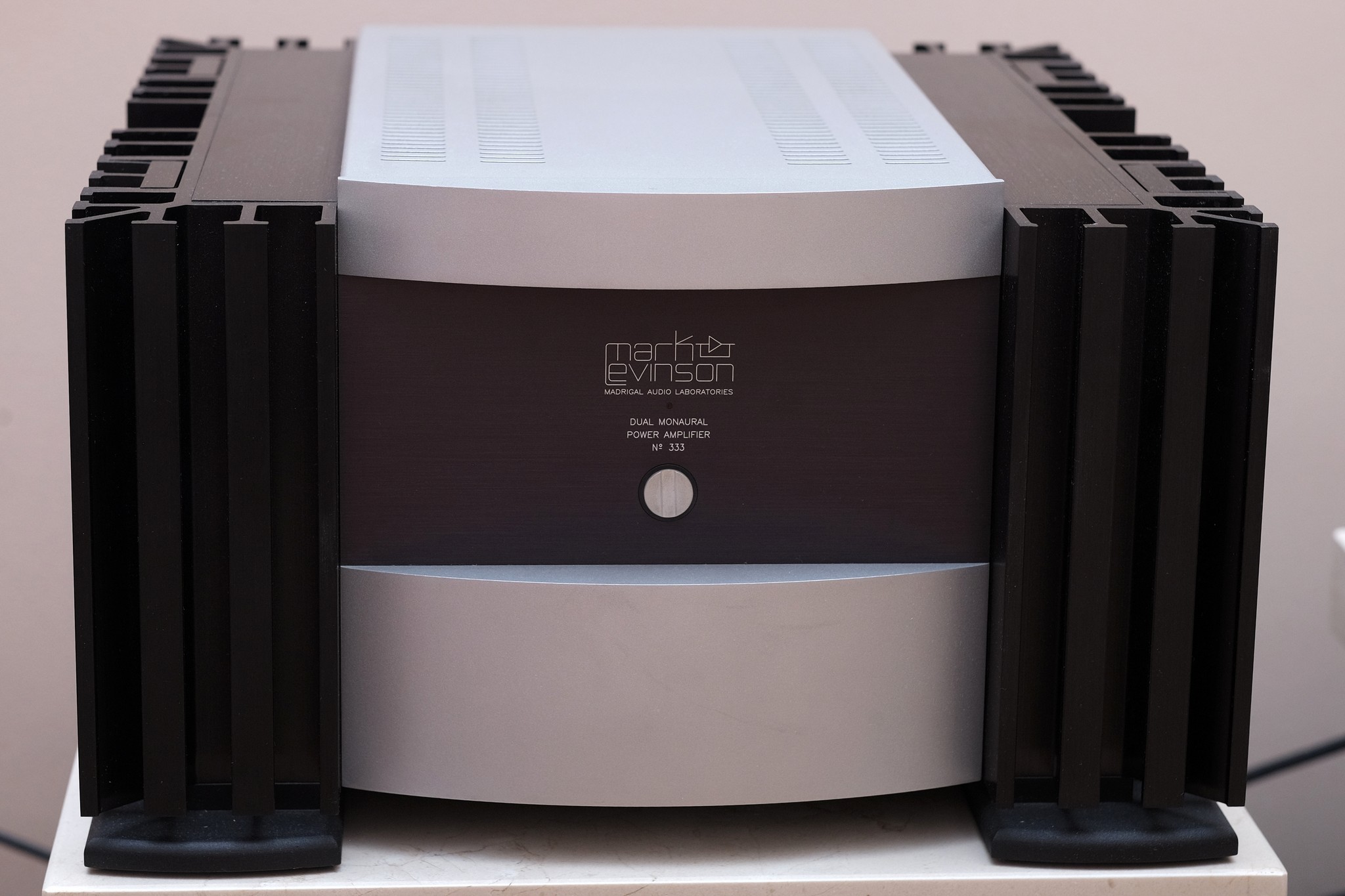
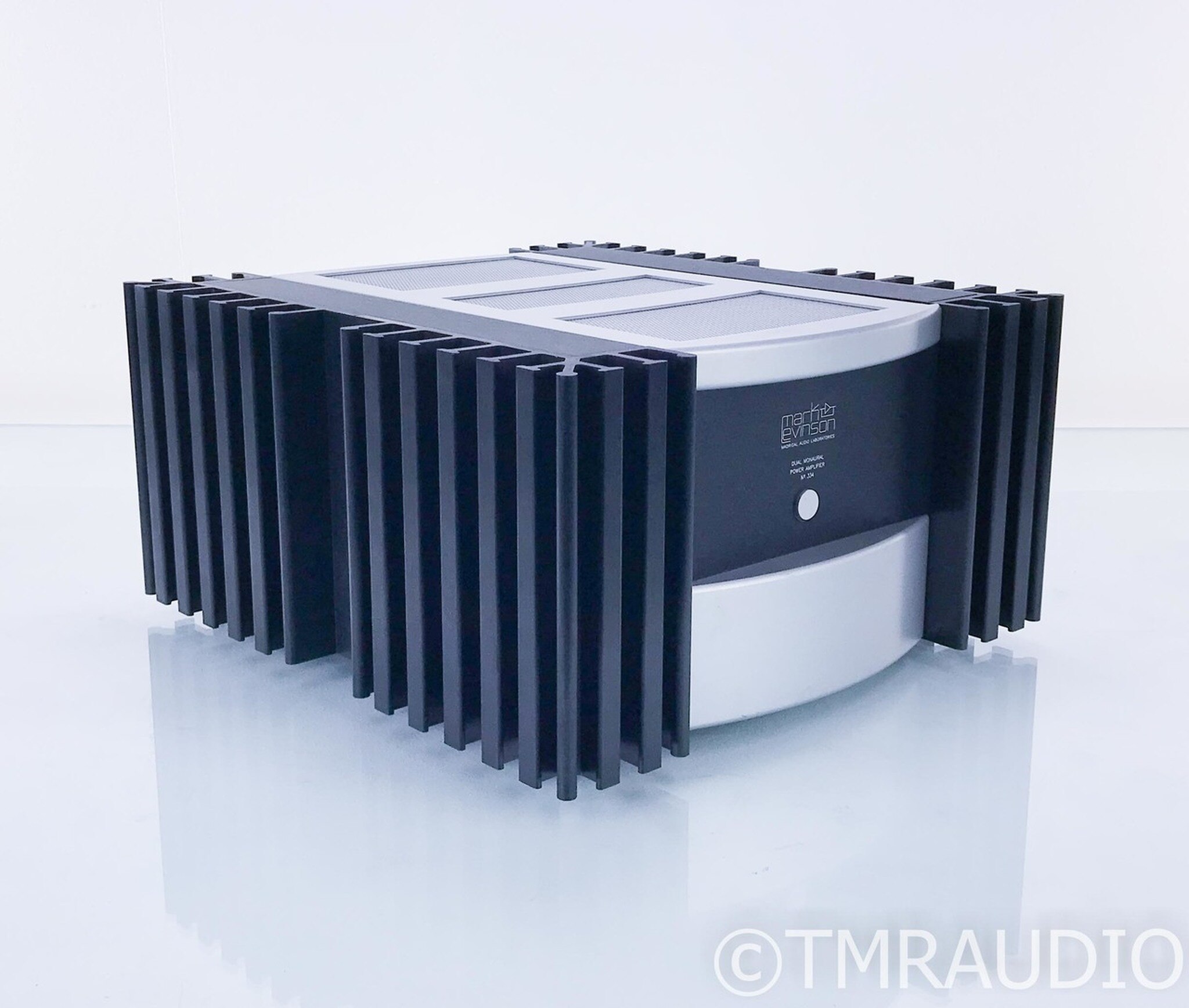
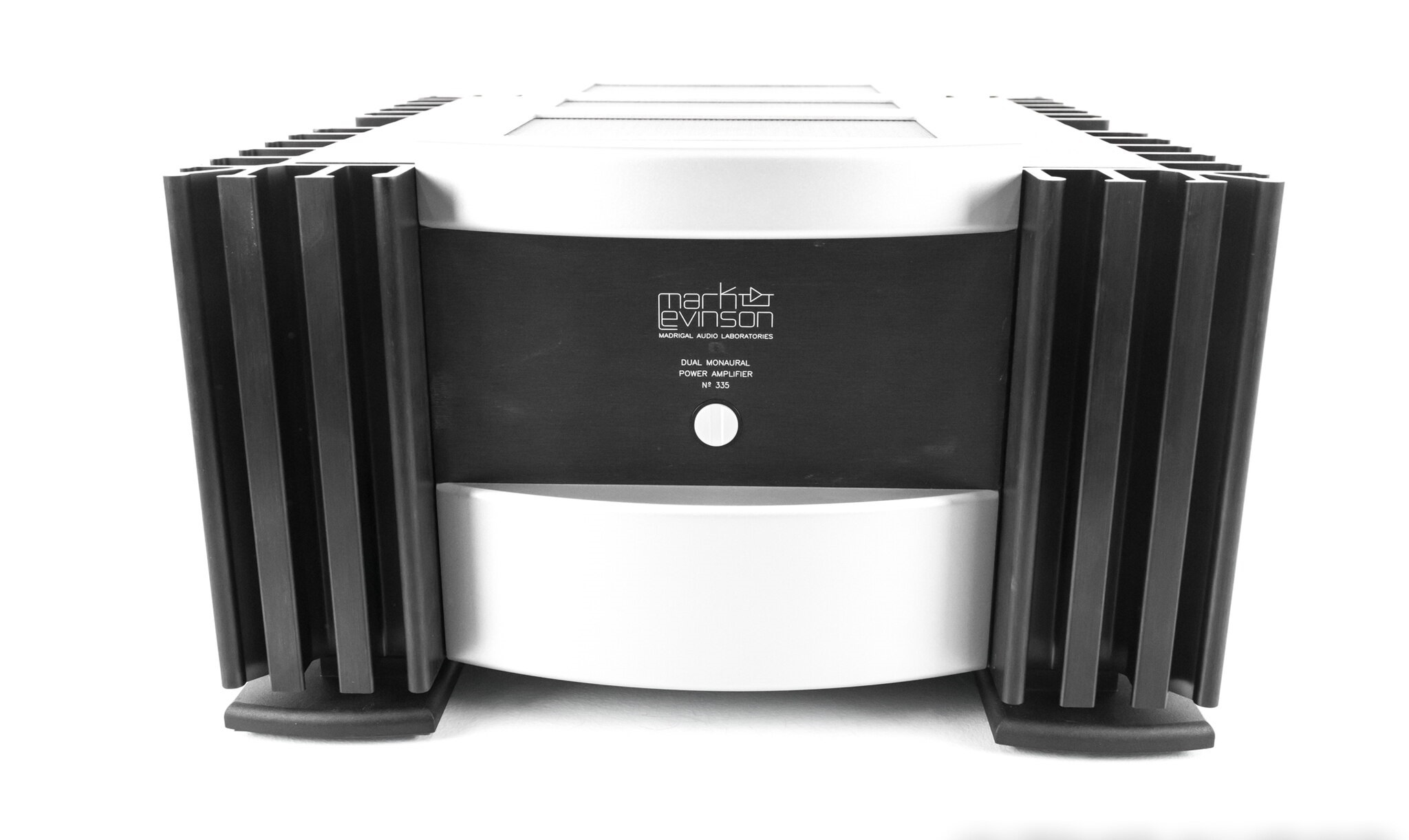
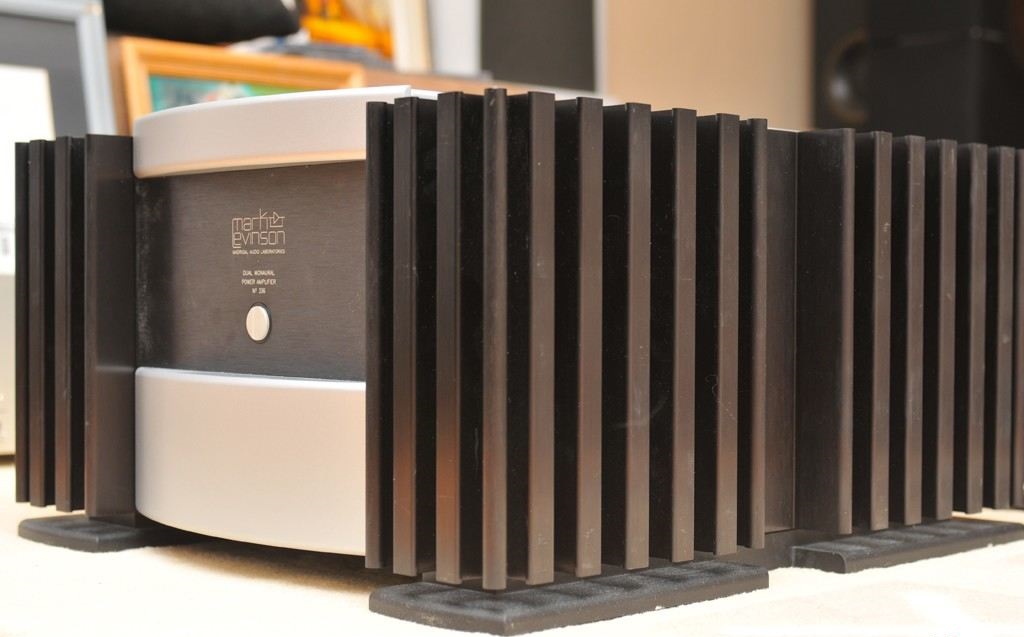
№ 331, 332, 333
№ 334, 335, 336
1995
A few of the technical highlights that make this possible are given below.
Massive Power Supply
Each Mark Levinson 300-series amplifier includes two large, completely independent power supplies—one for each channel.
Each supply includes a high capacity, low noise toroidal transformer, and two large, low ESR capacitors in each channel.
Since these are true, dual monaural designs, each channel has its own dedicated power supply.
Specifically, the amplifiers use: Nº336: two 2450 VA transformers four 50,000 µF capacitors.
Heavy oxygen-free copper bus bars enhance the efficiency of power distribution within the amplifier and eliminate variances introduced by the wiring harnesses, etc. more commonly found even in high performance amplifiers.
High frequency power supply bypass is accomplished on individual PC boards by five components of several film types.
The resulting uniformly low power supply impedance seen by the various circuits within the amplifier lays the foundation for both the massive power and the extraordinary finesse that characterizes the 300-series.
Balanced design
A truly balanced input topology eliminates the need for an input buffer amplification stage and allows the first stage differential amplifier to be driven directly by the source.
Matched impedances are presented to the source and both signals travel through identical circuit paths.
■ Nº331 Rated power output:
100 w/ch continuous rms power @ 8Ω
200 w/ch continuous rms power @ 4Ω
400 w/ch continuous rms power @ 2Ω all
■ Nº332 Rated power output:
200 w/ch continuous rms power @ 8Ω
400 w/ch continuous rms power @ 4Ω
800 w/ch continuous rms power @ 2Ω
■ Nº333 Rated power output:
300 w/ch continuous rms power @ 8Ω
600 w/ch continuous rms power @ 4Ω
1200 w/ch continuous rms power @ 2Ω
■ Nº334 Rated power output:
125 w/ch continuous rms power @ 8Ω
250 w/ch continuous rms power @ 4Ω
500 w/ch continuous rms power @ 2Ω
■ Nº335 Rated power output:
250 w/ch continuous rms power @ 8Ω
500 w/ch continuous rms power @ 4Ω
1000 w/ch continuous rms power @ 2Ω
■ Nº336 Rated power output:
350 w/ch continuous rms power @ 8Ω
700 w/ch continuous rms power @ 4Ω
1400 w/ch continuous rms power @ 2Ω
all above power ratings from 20 Hz–20kHz at <0.5% THD (assuming that the AC mains can deliver adequate current, without its own voltage sagging)
■ Frequency response: within 0.1 dB from 20 Hz to 20 kHz ■ Signal to Noise ratio (main outputs): better than –80 dB (ref. 1 w)
■ Input impedance: 100kΩ (balanced) 50kΩ (single-ended) ■ Voltage gain: 26.8 dB
■ Input sensitivity (2.83V output): 130 mV (all models)
■ Input sensitivity (full output): 2.25V for Nº333 1.80V for Nº332 1.30V for Nº331
■ Overall dimensions: See “Dimensions”
■ Nº333 Shipping weight: 150 lbs. (68.2kg) each
■ Nº332 Shipping weight: 150 lbs. (68.2kg) each
■ Nº331 Shipping weight: 112 lbs. (50.9kg) each
■ Nº336 Shipping weight: 150 lbs. (68.2kg) each
■ Nº335 Shipping weight: 150 lbs. (68.2kg) each
■ Nº334 Shipping weight: 112 lbs. (50.9kg) each
№ 35
1993
It comes as no surprise, then, that our subject here, Madrigal's "affordable" answer to the No.30, the new No.35, is smaller, lighter, cheaper, and contained entirely in one chassis.
But in terms of affordability, the No.35 is still well beyond the limits of most of our Visa cards.
Nevertheless, its designers have managed to bring it in at just over half the price of the No.30—a significant accomplishment.
Sound At the risk of giving away the farm before plowing the field, I'll state right up front that the Mark Levinson No.35 is absolutely state-of-the-art.
Used with the right transport, it provides digital playback which will likely satisfy all but the most unrepentant digiphobes.
It may not stop your yearning for the "good old days" of analog LPs available on every street-corner, but it points the way to a digital future worth looking forward to—a future that is here today in the No.35, though for a price.
Digital/analog processor.
Conversion and filtration: 20-bit, 8x-oversampling.
Input sampling rates: 32kHz, 44.1kHz, 48kHz.
Inputs: two AES/EBU, two S/PDIF, one ST coaxial, two EIAJ optical.
Outputs: RCA (unbalanced) and XLR (balanced).
Frequency response: 10Hz–20kHz +0dB, –0.2dB.
Total harmonic distortion: 0.003% at 1kHz, A-weighted. IM distortion (SMPTE IMD): <0.005%.
Output impedance: <6 ohms.
Dimensions: 19.325" (491mm) W by 5.63" (142mm) H by 15.625" (397mm) D.
Weight: 50 lbs (22.7kg). Serial number of tested unit: 1217.
Price: $7950.
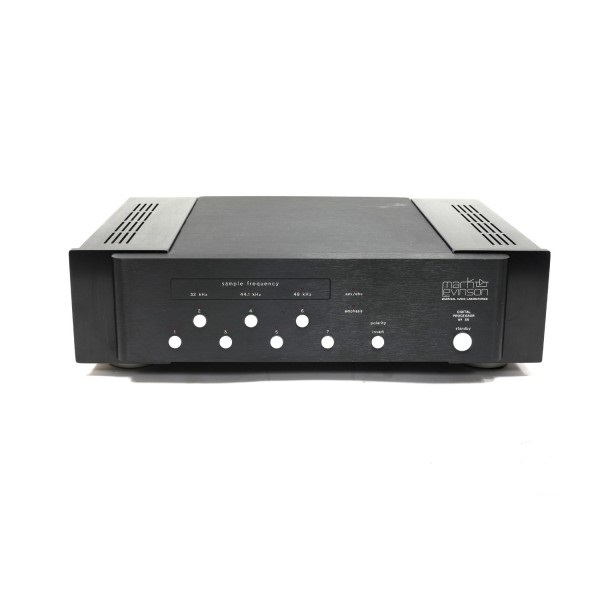
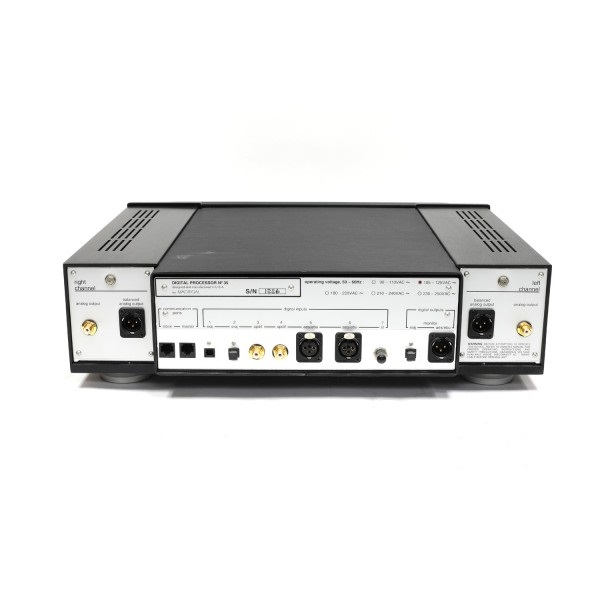
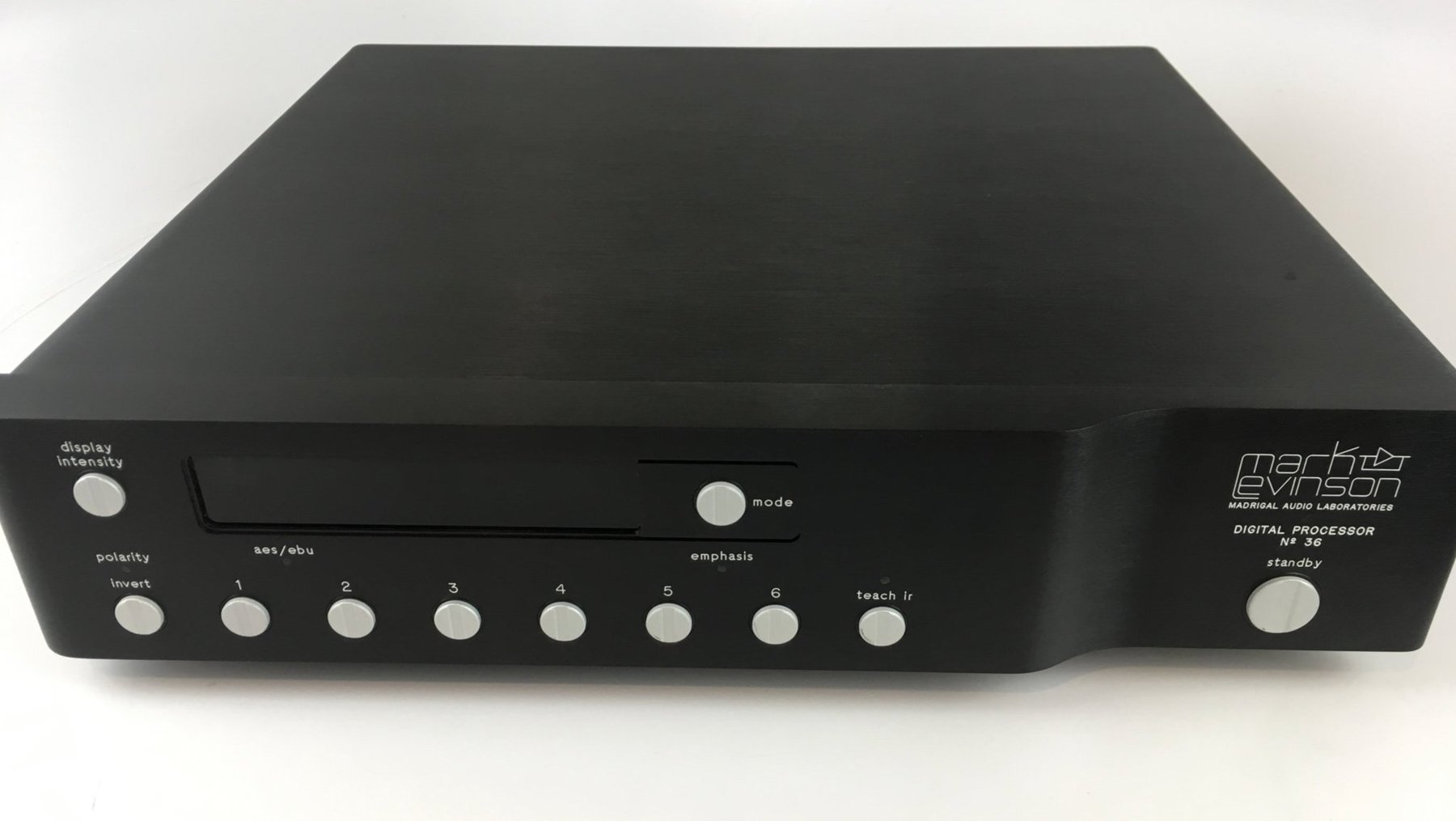
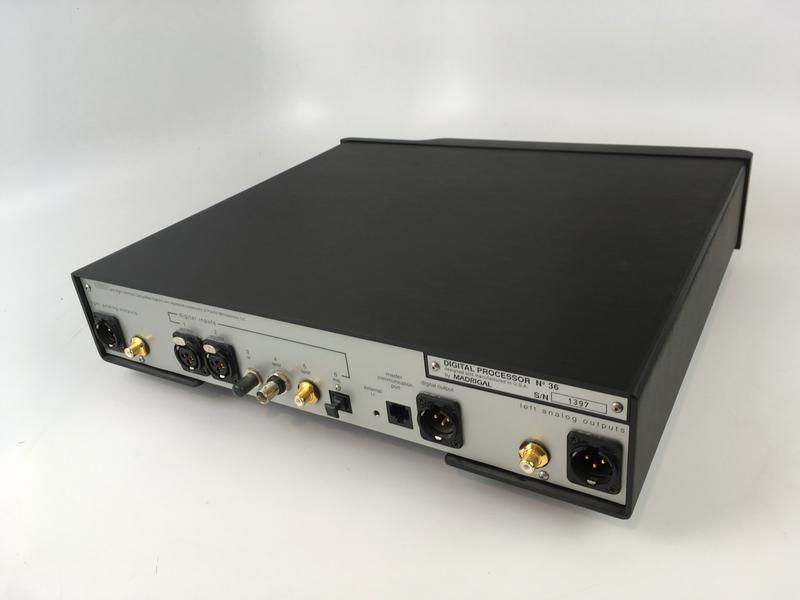
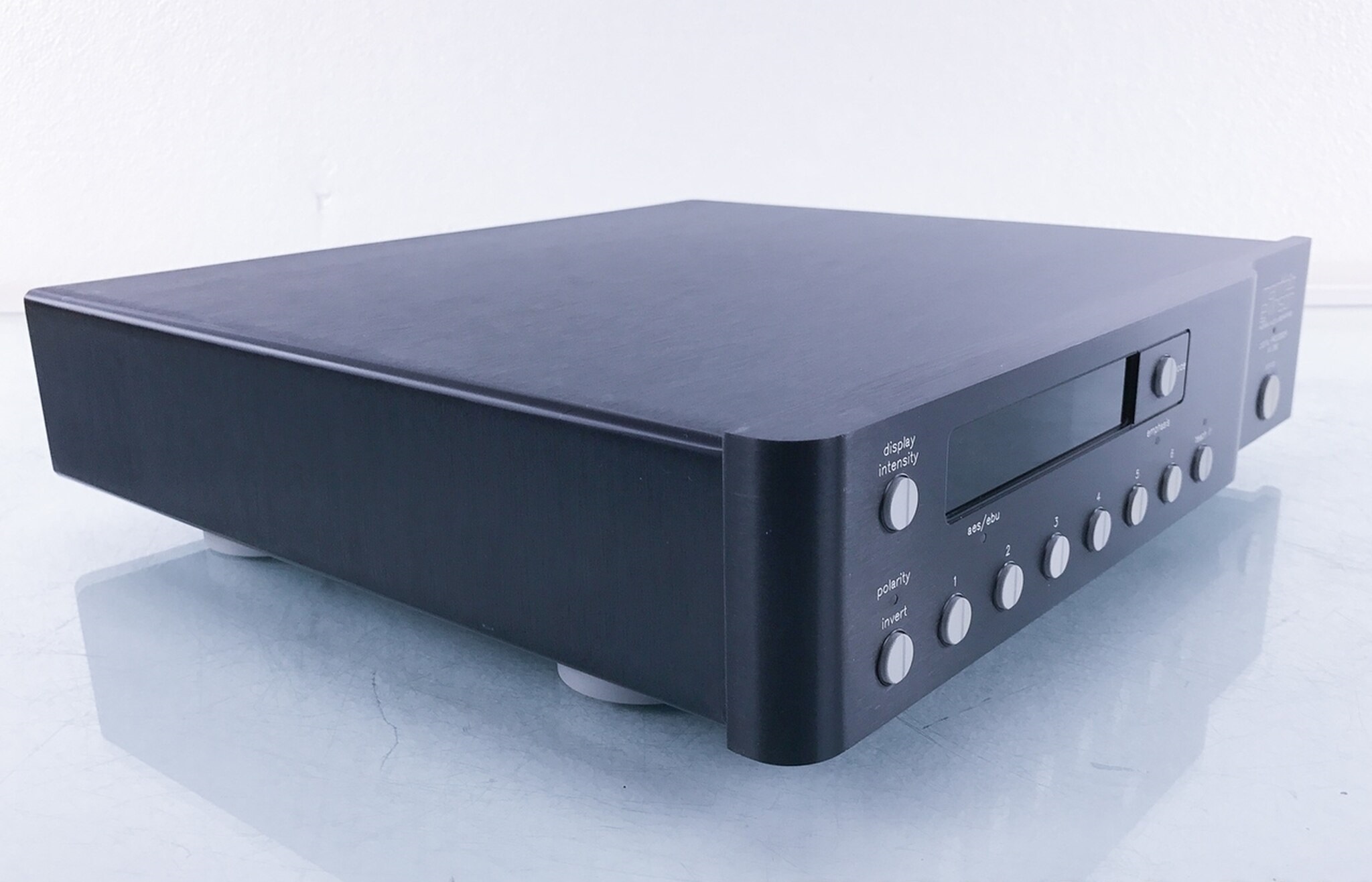
№ 36 & 36S
1995
The No.36
When Madrigal introduced their Mark Levinson No.30—now the No.30.5—its price put it out of reach of any but the most affluent or debt-tolerant audiophiles.
Add their No.31 transport, and you have a terrific combination which, unfortunately, turns up mostly in homes with four-car garages and security gates.
And when the less-expensive No.35 was introduced, we were still talking champagne and Brie.
Now, however, with the introduction of the No.36 (and the companion No.37 transport), Madrigal has a CD playback combination available to the merely terminally obsessed among us.
Conclusions
What can I say? Run out and buy the No.36? That would not be bad advice if you have the price of admission. It certainly must be heard, even if only to hear what's possible in today's best D/A converters. Make no mistake: the No.36 can compete in that company
The No.36S
The Levinson No.36S D/A converter is based, as noted above, on the No.36, and its external and operating features are virtually identical.
The No.36S also provides for HDCD playback though the inclusion of Pacific Microsonics' PMD100 HDCD, 24-bit throughput, 8x-oversampling HDCD decoder/digital filter chip. And, like the 36, the 36S handles HDCD's inherent 6dB-lower level in its own unique way.
While the DACs in both converters are the same, the trimming in the 36S is performed via 0.0006%-accuracy Vishay bulk-foil hand-trimmed resistors, vs Vishay 0.01% potentiometers in the 36. There are also numerous other improvements and upgrades to the digital power supply, DAC bypass caps, digital clock, various improved capacitors, resistors, and internal cabling, and DAC shielding.
Conclusions
The 37/36S is far less expensive than Levinson's 31.5/30.5 combination, and in my judgment only those who simply like to spend lots of money would now choose the flagship pair—particularly with DVD for audio (which will require all new replay equipment) somewhere in the visible but still slightly fuzzy future. But CD is here today, and no CD playback device I know of will do the job better than the Levinson No.37 and No.36S.
Digital processor with HDCD decoding.
Inputs: two AES/EBU on XLRs, two S/PDIF coaxial (one RCA, one BNC), one ST optical, one TosLink optical.
Outputs: L/R balanced (XLR) and unbalanced (RCA) analog out. Digital out. Also one RJ-45 communications port (see text) and IR repeater port.
Frequency response: 10Hz–20kHz, +0, –0.2dB.
Dynamic range: 98dB (or better). S/N ratio: 105dB. Channel separation: >110dB. FIFO jitter: <20 picoseconds, uncorrelated. Output impedance: <6 ohms.
Dimensions: 15.75" W × 14.3" D × 3.75" H.
Weight: 35lb. Serial number of unit reviewed: 1080.
Price: $3995
№ 360 & 360S
1999
The No.360,
the successor to the No.36 (which can be upgraded to 360S status), sits under the $6995 "special performance" No.360S in the hierarchy of Levinson DACs and features a Madrigal-designed input receiver circuit (DIR) rather than off-the-shelf chips.
Levinson's receiver circuits are based on a wide-bandwidth gate array and are programmable to permit future compatibility with new audio data formats.
The heart of the DAC, however, is a 32-bit SHARC digital signal processor, which performs as an oversampling filter and HDCD decoder and interfaces with the FIFO and DAC circuits.
Additionally, this DSP might be reprogrammable to handle formats such as Dolby Digital, DTS, MPEG, and MLP, making the No.360 series almost obsolescence-proof.
The Mark Levinson No.360 joins the very short list of components whose neutrality makes them less impressive in facile A-B comparisons than in extended listening.
The No.360 does not favor any part of the audible spectrum, does not present an enhanced soundstage, and does not emphasize dynamic contrasts. What it does seem to do is present an extremely detailed and uncolored sonic image that invites long and involving listening.
Digital/analog converter with dual-differential 24-bit/96kHz DACs.
Input data rates accepted up to 96kHz. DSP processor, full remote control, HDCD decoding, 8x oversampling digital filter, Bessel-tuned, linear-phase analog filter and phase inversion switching.
Digital inputs: 2 AES/EBU, ST, TosLink, RCA, BNC.
Digital output: XLR.
Fixed-volume analog outputs: XLR balanced, RCA unbalanced.
Shipping weight: 35 lbs (15.9kg).
Price: $4495.
The No.360S
This unit started out as No.36S DAC before going back to Mark Levinson for a full "Factory Official" upgrade to the No.360s.
While it was a very expensive upgrade, it was well worth the price and benefited greatly by the addition of four PCM1704 multibit DAC chips.
The label on the bottom reads "360S" (see photo), and a quick look at the internals confirms this addition. The inside is stuffed with PC boards, larger power supplies, and more complex circuitry which almost looks like it could power a super computer! It also gains the ability to decode HDCD.
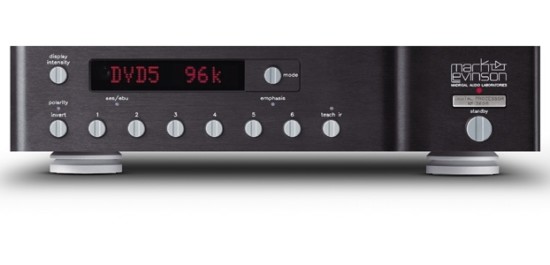
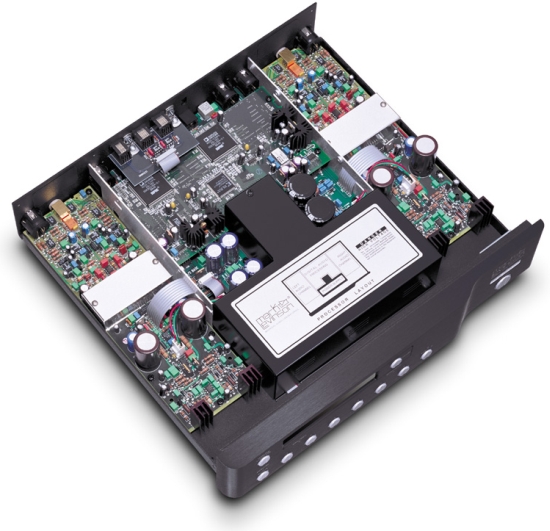
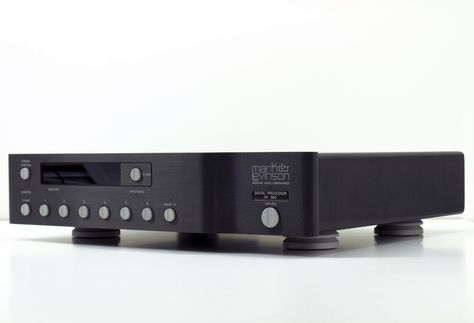
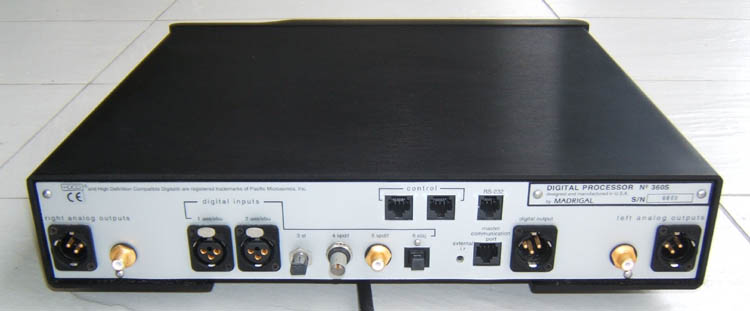
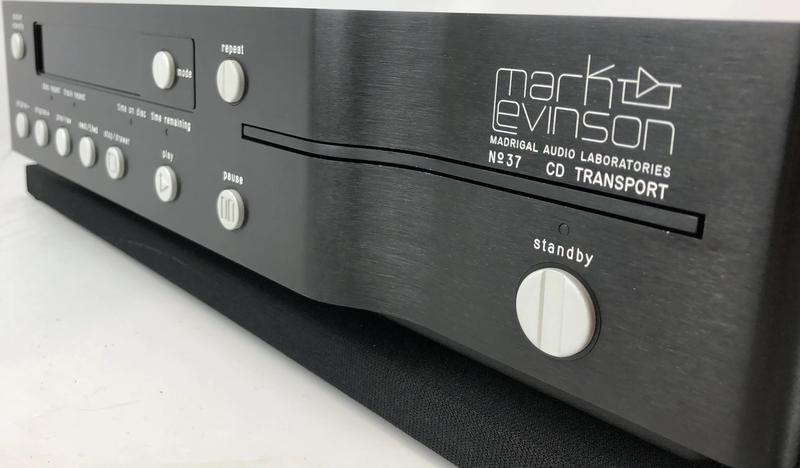
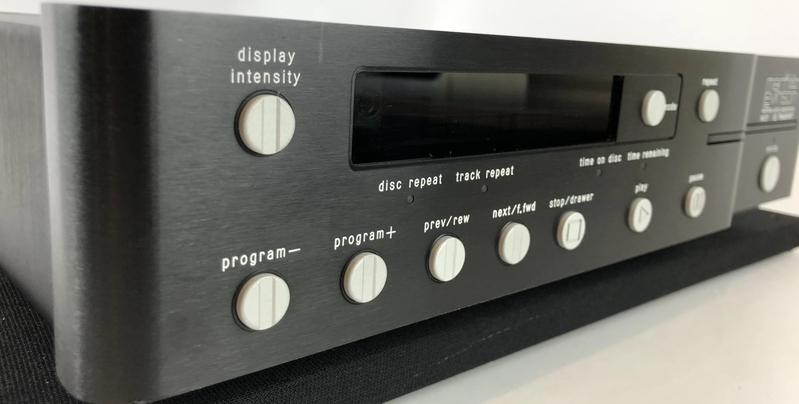
№ 37
1995
he Mark Levinson Nº37 CD Transport is dedicated to performing one highly specialized task: to extract all of the digital information from a CD and relay it to a digital processor in its original form.
Sound
The Mark Levinson No.36S and No.37 comprise the finest CD-playback combination—or one-piece player—I have ever had in my system.
Yes, the same manufacturer's No.30.5 D/A and No.31.5 transport together bookend an engineering tour de force, but unless your name is Ross Perot or Bill Gates, I'm not at all certain how I feel about recommending a $25,000 digital front-end.
True, the $10,490 cost of the No.36S/37 combination also lies on the slippery slope to bankruptcy for most of us, but that extra $15,000 will still buy a few good dinners.
No.37 Description:
CD transport with four digital outputs: AES/EBU on XLR, S/PDIF on BNC, S/PDIF on RCA, ST optical.
Weight: 34 lbs (shipping).
Price: $3995.
№ 38, 38s
1993
The new Mark Levinson No.38 is a revolutionary leap forward in preamplifier functionality, convenience, and user interface. Its sophisticated array of features redefines the role of a preamplifier in a music system. The volume control was sheer magic, and particularly useful for precisely repeating volume levels.
On a sonic and musical basis, the No.38 offered excellent performance.
No 38
Price: $3995 (1995)
No 38S
Expensive it may be, but the Mark Levinson No.38S was the most neutral and at the same time most musically satisfying preamplifier to spend time in my system.
Taken as a package, the No.38S had no weaknesses. It sounded simply superb. Weight: 35 lbs (16kg)
Price: $6495 (1995)
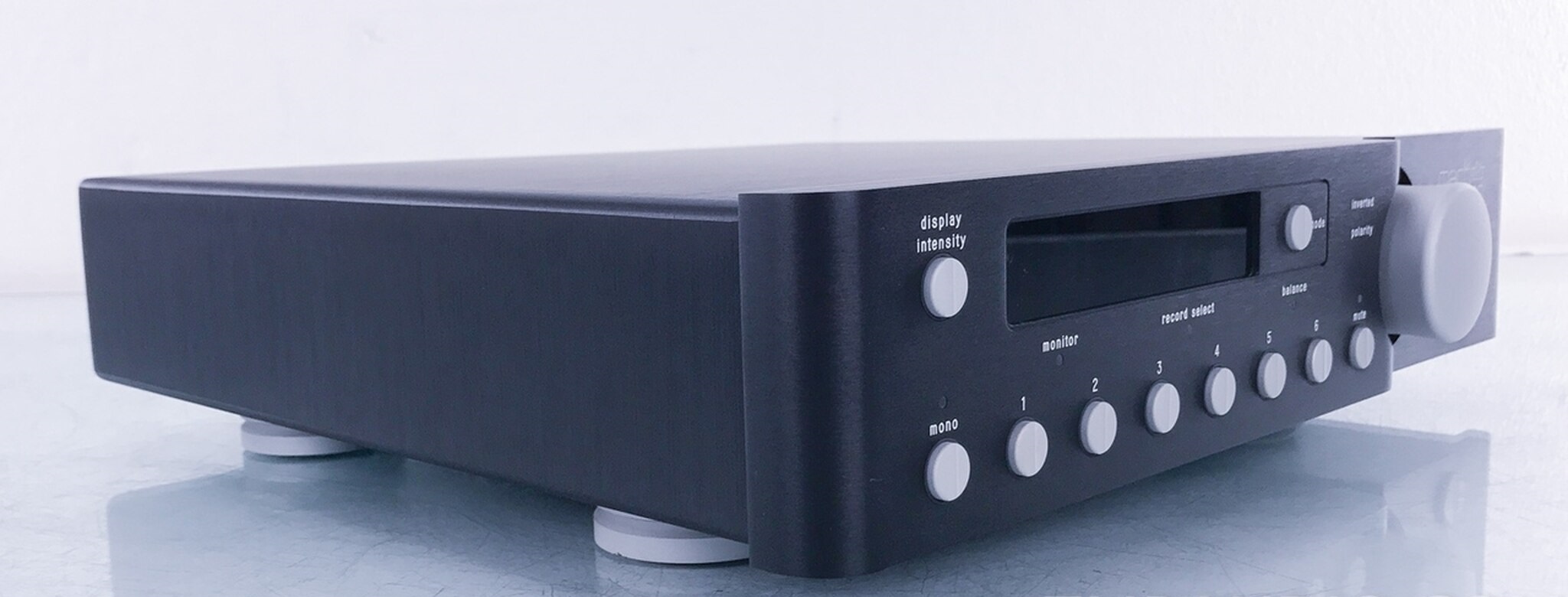


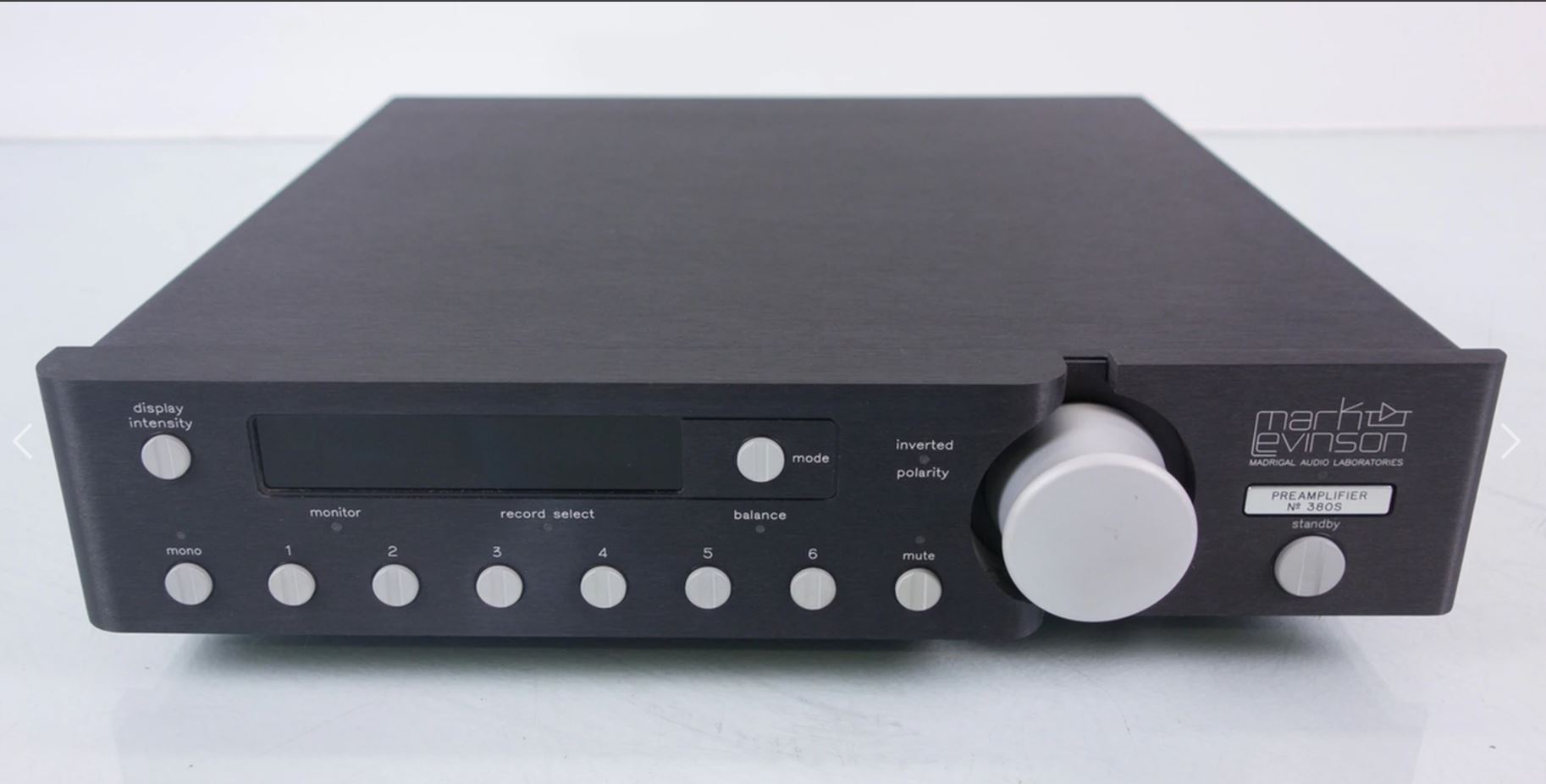

№ 380, 380s
1995
Second, how do you describe the sound of something that's superficially identical to your reference, but better? Audiophiles habitually refer to sonic differences between two components in terms of differences in frequency balance: A had more bass, B had more treble, C had a depressed midrange.
But when comparing the two Levinson preamps, I kept hearing how similar they were on these terms. There were no response or balance differences that
I could confidently hang my hat on, yet there was a musical rightness to the sound of the '380S that I consistently preferred. Stereo images seemed better-defined, and individual sonic objects within those images had more of a rounded, fleshed-out character.
In the deathless prose of Sam Tellig, there was simply more "there" there. And more "air" there, if you will. This was an area where the original '38S had been showing its age in light of the performance offered by two of the preamps I've been listening to in Wes Phillips' system: the Conrad-Johnson Premier 14 and Ayre K-1.
Not that the '38S was a sonic slouch—far from it. In fact, when we used it to provide some gain to drive the disc-cutting amplifiers when we mastered Stereophile's Sonata LP (see "Cutting Up," Vol.20 No.3), we were impressed by how little it got in the way of the music.
But the No.380S just went that essential bit further. A small difference in objective terms, but one that is, subjectively, enormously important. I can confidently recommend the No.380S as my solid-state preamplifier of choice.
№ 39
2002
What I can say is that the Mark Levinson No.39 reproduces music on the most exalted level; that it is well-built and reliable; that it offers an awful lot of intelligently implemented options to anyone looking for a CD player, a digital processor, or a switching unit; and that its volume control is superior to, or the equal of, that of almost any preamp I've ever heard.
That's aplenty, as they say. Factor in the price, and it's pretty much a no-brainer. Anyone looking for topnotch digital sound has simply got to try the No.39. Even if all they want is a CD player.
Price: $5995
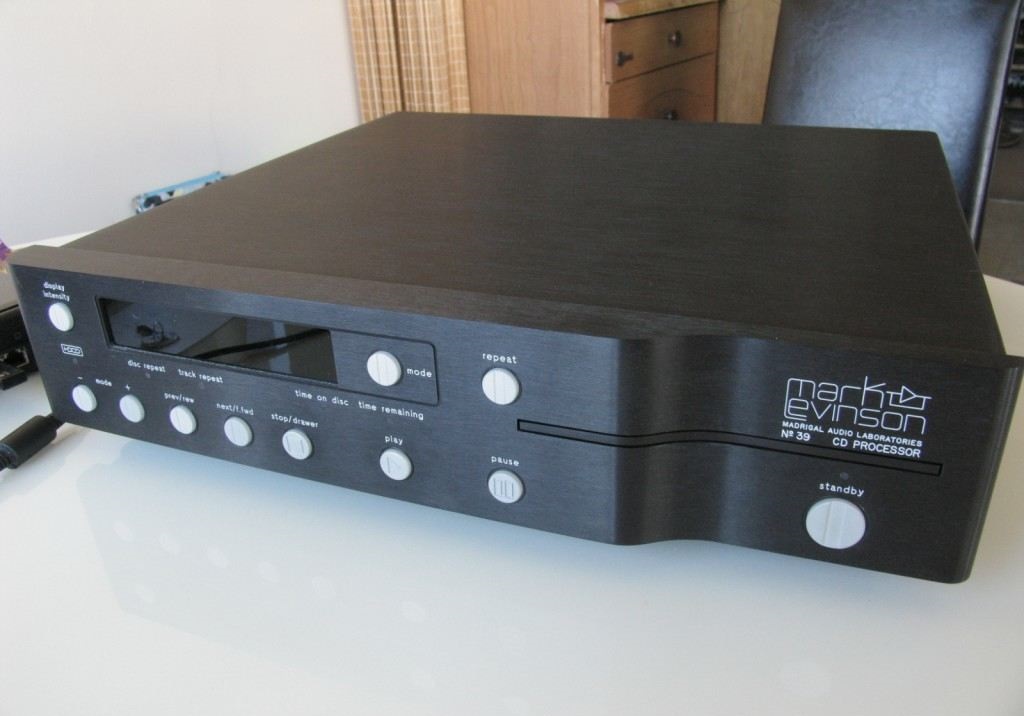
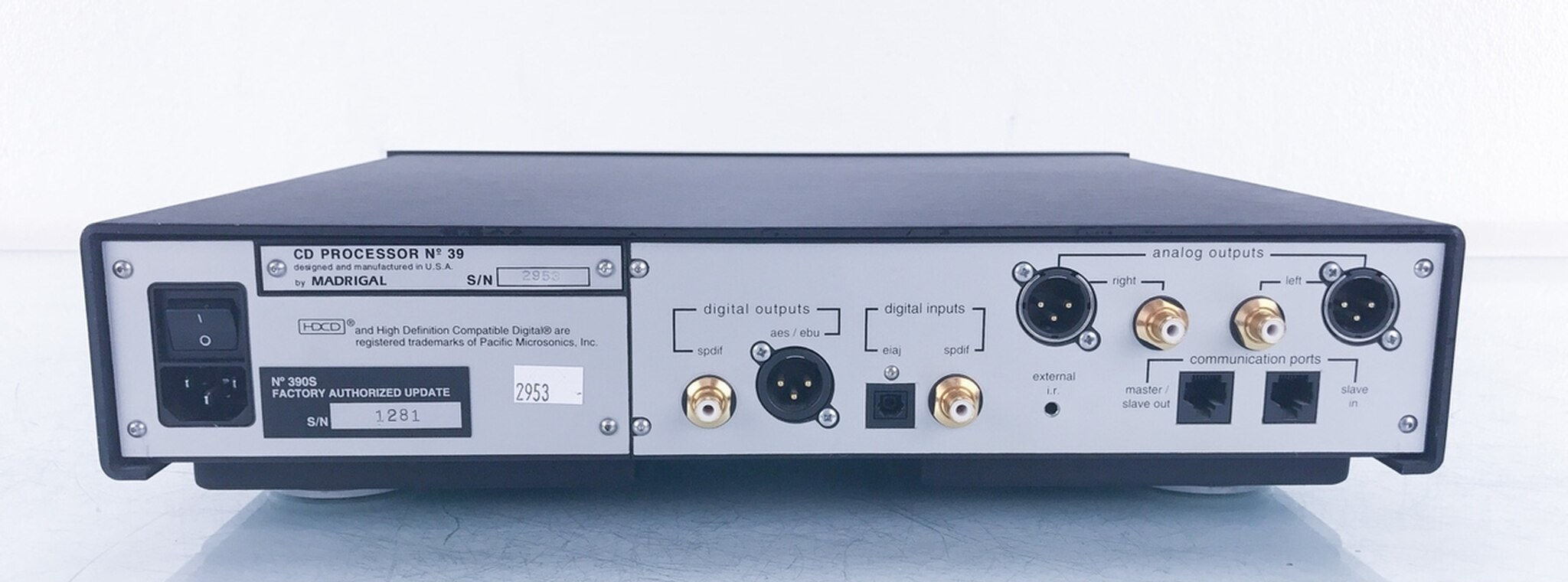
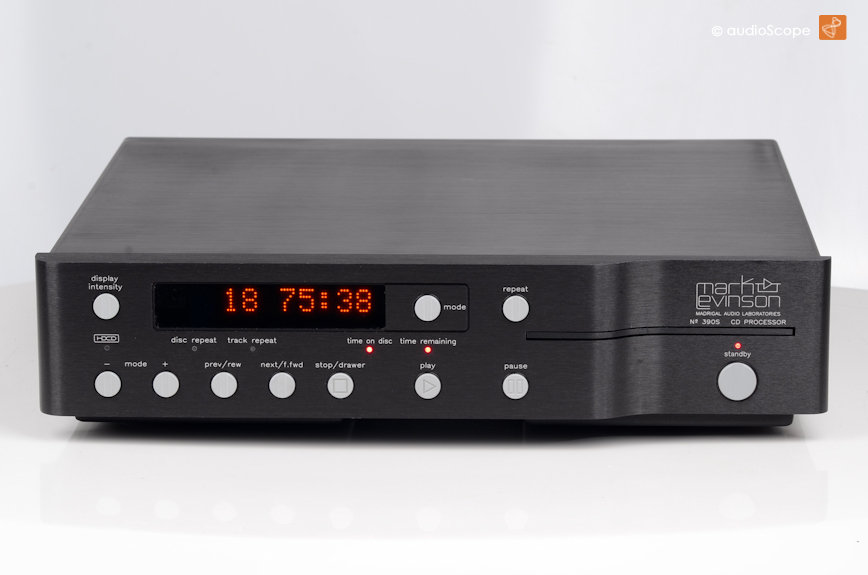
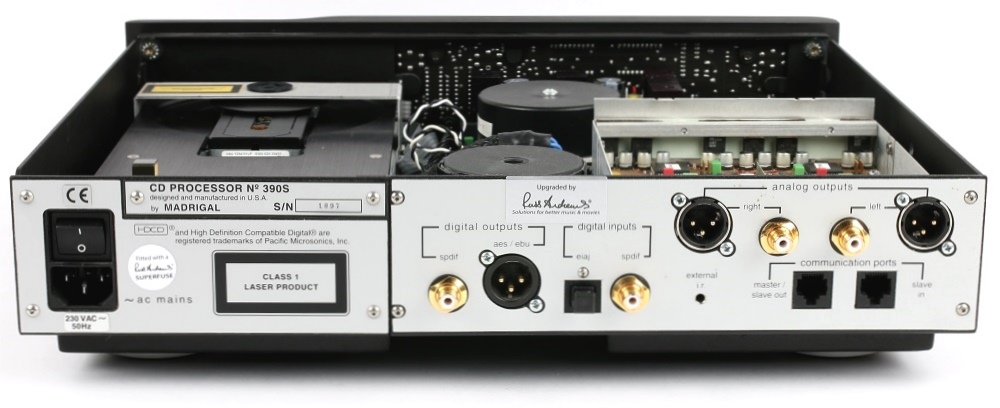
№ 390s
2004
With its classic appearance, its superb sound from CD, and its transparent-sounding volume control allowing it to be used without a preamplifier, the Mark Levinson No.390S comes close to justifying its asking price of $6700.
Against the $6000 Musical Fidelity Tri-Vista SACD player—using only CDs, of course—and again with levels matched at 1kHz, the No.390S's soundstage was actually a little deeper than that of the tubed player, but its presence region was a little more forward, its midrange very slightly less rich-sounding.
Weight: 50 lbs (23kg)
Price: $6700